Sony A1031011 Licensed Transmitter User Manual Exhibit 8
Sony Mobile Communications Inc Licensed Transmitter Exhibit 8
Sony >
Contents
- 1. Exhibit 8 User manual
- 2. Exhibit 8 User Manual
- 3. Exhibit 8 User Manual revised
Exhibit 8 User manual
Contents 1
Contents
Getting to know your phone 4
Key functions, quick keys, entering letters.
Personalizing your phone 17
Download settings or choose from the phone.
Calling 25
Use the Phonebook, voice control, call options.
Messaging 45
Multimedia messaging, chat and email.
Camera 53
Use the camera.
Setting up WAP and Email 56
All you need to know about setting up WAP and email.
Using WAP 63
WAP browser, bookmarks.
Transferring and exchanging information 66
Bluetooth wireless technology, synchronization.
More features 70
Calendar, alarm clock, stopwatch, timer, games.
Security 78
SIM card lock, phonelock.
Troubleshooting 79
Why doesn’t the phone work the way I want?
Additional information 81
Safe and efficient use, warranty, declaration of conformity.
Icons 89
What do the icons mean?
Index 95
T610UG-R3A.book Page 1 Tuesday, May 27, 2003 5:16 PM
2 Contents
Sony Ericsson
First edition (May 2003)
This manual is published by Sony Ericsson Mobile
Communications AB, without any warranty.
Improvements and changes to this manual
necessitated by typographical errors, inaccuracies
of current information, or improvements to programs
and/or equipment, may be made by Sony Ericsson
Mobile Communications AB at any time and without
notice. Such changes will, however, be incorporated
into new editions of this manual.
All rights reserved.
©Sony Ericsson Mobile Communications AB, 2003
Publication number: AE/LZT 123 7545 R1
Please note:
Some of the services in this manual are not supported
by all networks. This also applies to the GSM
International Emergency Number 911 or 112.
Please contact your network operator or service
provider if you are in doubt whether you can use
a particular service or not.
Please read the Guidelines for safe and efficient use
and the Limited warranty chapters before you use
your mobile phone.
The BLUETOOTH trademarks are owned by
Bluetooth SIG, Inc.
T9™ Text Input is a trademark or a registered
trademark of Tegic Communications.
T9™ Text Input is licensed under one or more of the
following: U.S. Pat. Nos. 5,818,437, 5,953,541,
5,187,480, 5,945,928, and 6,011,554; Canadian Pat.
No. 1,331,057, United Kingdom Pat. No. 2238414B;
Hong Kong Standard Pat. No. HK0940329; Republic
of Singapore Pat. No. 51383; Euro.Pat. No. 0 842
463(96927260.8) DE/DK, FI, FR, IT, NL, PT, ES, SE,
GB; and additional patents are pending worldwide.
Java and all Java based trademarks and logos are
trademarks or registered trademarks of Sun
Microsystems, Inc. in the U.S. and other countries.
End-user license agreement for Sun™ Java™
J2ME™.
1. Restrictions: Software is confidential copyrighted
information of Sun and title to all copies is retained by
Sun and/or its licensors. Customer shall not modify,
decompile, disassemble, decrypt, extract, or
otherwise reverse engineer Software. Software may
not be leased, assigned, or sublicensed, in whole or
in part.
T610UG-R3A.book Page 2 Tuesday, May 27, 2003 5:16 PM
Contents 3
2. Export Regulations: Software, including technical
data, is subject to U.S. export control laws, including
the U.S. Export Administration Act and its associated
regulations, and may be subject to export or import
regulations in other countries. Customer agrees to
comply strictly with all such regulations and
acknowledges that it has the responsibility to obtain
licenses to export, re-export, or import Software.
Software may not be downloaded, or otherwise
exported or re-exported (i) into, or to a national or
resident of, Cuba, Iraq, Iran, North Korea, Libya,
Sudan, Syria (as such listing may be revised from
time to time) or any country to which the U.S. has
embargoed goods; or (ii) to anyone on the U.S.
Treasury Department's list of Specially Designated
Nations or the U.S. Commerce Department's Table of
Denial Orders.
3. Restricted Rights: Use, duplication or disclosure by
the United States government is subject to the
restrictions as set forth in the Rights in Technical Data
and Computer Software Clauses in DFARS 252.227-
7013(c) (1) (ii) and FAR 52.227-19(c) (2) as
applicable.
Part of the software in this product is copyright ©
SyncML initiative Ltd. (1999-2002). All rights
reserved.
Other product and company names mentioned herein
may be the trademarks of their respective owners.
Any rights not expressly granted herein are reserved.
T610UG-R3A.book Page 3 Tuesday, May 27, 2003 5:16 PM

4 Getting to know your phone
Getting to know your phone
About this user’s guide
The “Getting to know your phone” chapter gives a
quick overview of the main functions of the phone,
shortcuts and general information.
More information and downloads are available at
www.SonyEricsson.com/ or wap.SonyEricsson.com/
Available services
Some services and functions described in this user’s
guide are network or subscription-dependent, which
means that all menus may not be available in your
phone.
This symbol indicates that a service or
function is network or subscription-
dependent.
Please consult your network operator for
more information about your subscription.
Assembly
Before you can use your phone you need to:
• Insert the SIM card.
• Attach and charge the battery. See “SIM card and
battery information” on page 5.
Note: Always turn off the phone and detach the
charger before you insert or remove a SIM card.
The SIM card
When you register as a subscriber with a network
operator, you get a SIM (Subscriber Identity Module)
card. The SIM card contains a computer chip that
keeps track of your phone number, the services
included in your subscription, and your Phonebook
information, among other things.
Tip: Check if your information is saved to the SIM
card before you remove it from another phone. For
example, Phonebook entries may be saved in the
phone memory.
T610UG-R3A.book Page 4 Tuesday, May 27, 2003 5:16 PM
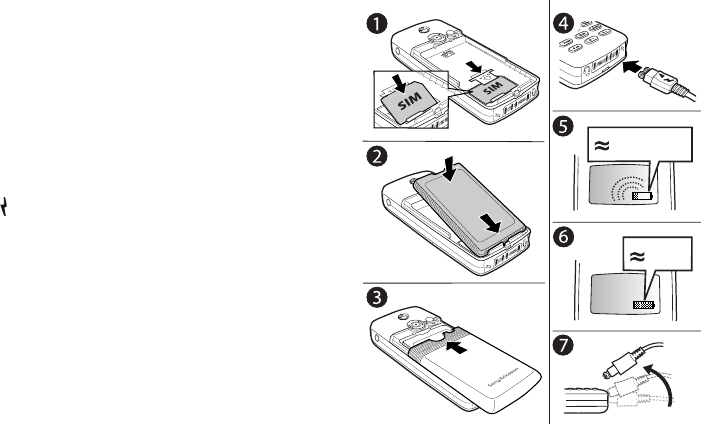
Getting to know your phone 5
SIM card and battery information
It may take up to 30 minutes before an icon
appears when charging.
1. Insert the SIM card. Slide the metal holder over the
SIM card to lock it in place.
2. Place the battery on the back of the phone with the
label side up.
3. Place the back cover as shown in the picture and
slide it into place.
4. Connect the charger to the phone at the flash symbol
( ). The flash symbol on the charger plug must face
upwards.
5. It may take up to 30 minutes before the battery
charging icon appears in the display.
6. Wait approximately 4 hours or until the icon
indicates that the battery is fully charged. If you do
not see the battery icon after this time, press any key
or the joystick to activate the display.
7. Remove the charger by tilting the plug upwards.
Note: You have to insert the SIM card and charge
the battery before you can use the phone.
a
b
30 min.
4 h.
T610UG-R3A.book Page 5 Tuesday, May 27, 2003 5:16 PM
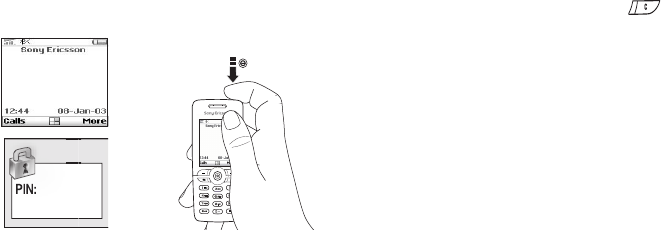
6 Getting to know your phone
Turning the phone on
To turn on the phone
Press and briefly hold the on/off button on the top of
the phone.
Note: The first time you turn on the phone it takes
up to 40 seconds to begin operating.
• Enter your PIN (Personal Identity Number), if you
have one for your SIM card.
Your PIN is provided by your network operator.
If you make a mistake while entering your PIN,
delete the wrong number by pressing .
When you enter your pin, the digits will be masked
with an asterisk (*). Do not choose emergency
numbers for your PIN because emergency numbers
are not masked. Some number sequences may not be
hidden because they could be part of an emergency
number sequence.
Note: If you enter the wrong PIN three times in a
row, the SIM card is blocked and the message "PIN
blocked" appears. To unblock it, you need to enter
your PUK (Personal Unblocking Key). Your PUK is
provided by your network operator.
To turn off the phone
Press and hold the on/off button at the top of the phone.
on/off
Wel
T610UG-R3A.book Page 6 Tuesday, May 27, 2003 5:16 PM
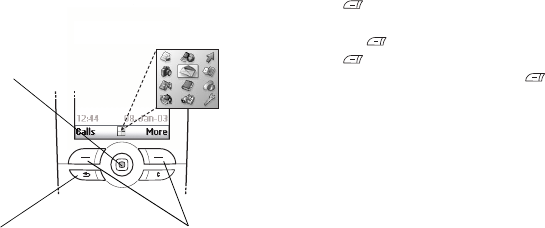
Getting to know your phone 7
Navigating the menus
The main menus are shown as icons on the desktop.
To go to the desktop, press the joystick.
Example
To set an alarm
1. Use the joystick to scroll to Organizer, and press the
left key to select it.
2. Use the joystick to scroll down to Alarms, and press
the left key to select this function. Press the
left key again to select Alarm.
3. Enter the time and press the left key to save
your entry.
Throughout this user’s guide instructions such as those
above will be given in a shorter form, as follows:
To set an alarm
1. Scroll to Organizer, Alarms, Alarm.
2. Enter the time, Save.
To make and receive calls from standby
• Enter the area code and phone number, press Call.
• Press End Call to end the call.
• When the phone rings, press Yes to answer the call.
Desktop
Press to go back one
level in the menus.
Press and hold to
return to standby.
Move up,
down, left,
right through
menus.
Press to select
highlighted
items.
Press to select the
options shown
above these keys
in the display.
T610UG-R3A.book Page 7 Tuesday, May 27, 2003 5:16 PM
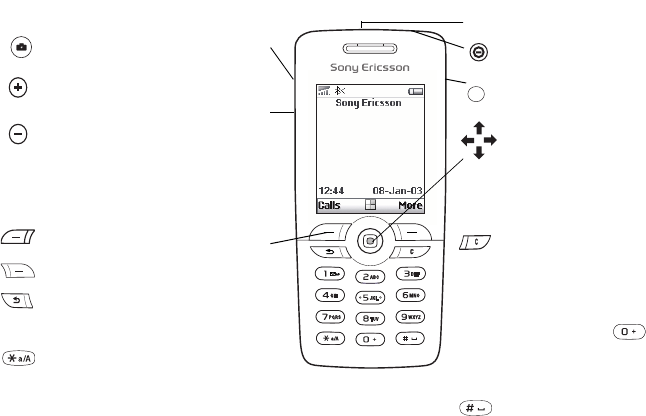
8 Getting to know your phone
Key functions
Press once to activate camera
function. Press again to take a
picture.
Volume keys increase/decrease
the earpiece volume during a
call. Scroll through menus, lists
and text. Enter the Status menu
in standby. Press twice to reject
an incoming call. Press once to
mute the ring tone when
receiving a call.
Press to select the options that
appear in the display
immediately above these keys.
Press once to go back one
level in the menus. Press and
hold to return to standby.
Enter *.
Shift between lower/upper
case when entering text.
Infrared port.
Press and hold to switch the
phone on or off.
Press to go directly to the
Internet.
4-way navigation and center
select allows you to move
through the menus, lists and
texts. The arrows indicate the
direction to tilt the joystick.
Press down on the joystick to
select an option.
Delete numbers, letters or an
item from a list. Press and
hold to mute the microphone
(during calls) or mute sound.
1-9, 0 Enter digits, 0–9, and letters.
Press and hold to enter
the international prefix +.
Press 7 to enter a pause. Press
9 to enter a question mark (?).
Enter # or a space.
T610UG-R3A.book Page 8 Tuesday, May 27, 2003 5:16 PM
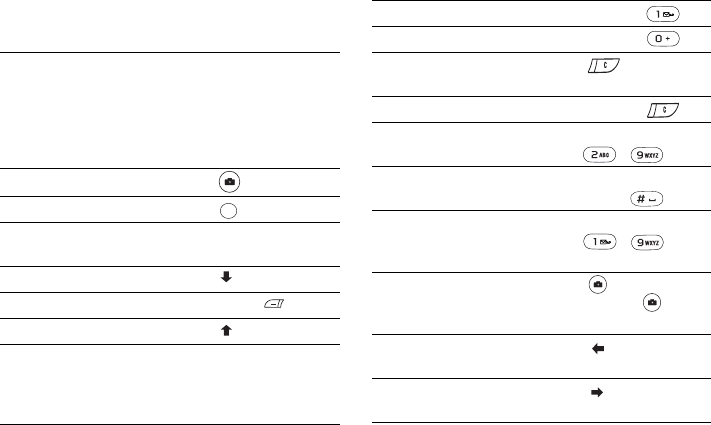
Getting to know your phone 9
Quick keys
Useful key combinations are described below.
To... When in standby:
Quickly access the main
menu items Tilt the joystick to the
right. Then, press the
digit key that
corresponds to the
location of the menu
icon.
Start the camera Press
Go directly to the internet Press
make an emergency call enter the emergency
number and press Call
enter Call Contact press
enter Call List press Calls ( )
enter Internet Services press
voice dial press and hold a volume
key or say your magic
word (when voice dial
is on)
call your voicemail press and hold
enter the + sign press and hold
mute the ring tone when
receiving a call press , or press a
volume key once
set the phone to silent press and hold
reach a contact beginning
with a specific letter press and hold any of the
keys -
reach a phone number at a
specific position. press the position
number and
speed dial press any of the number
keys - and
Call
Take a picture Press to start the
camera. Press again
to take a picture.
enter the first submenu of
the shortcut menu press
enter the main menu press or press the
center of the joystick
To... When in standby:
T610UG-R3A.book Page 9 Tuesday, May 27, 2003 5:16 PM
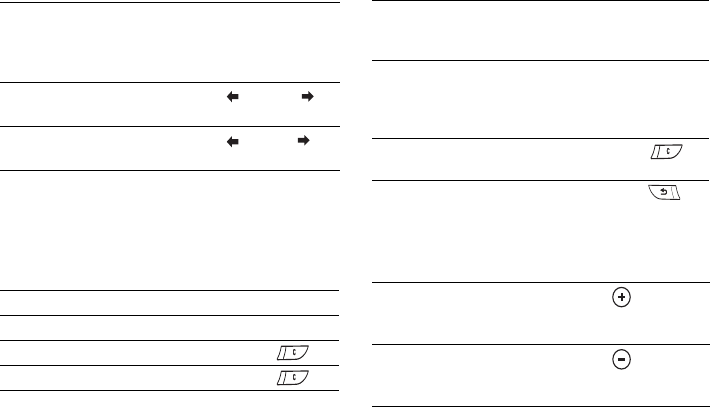
10 Getting to know your phone
enter the menu to see
today’s date, the profile in
use and the model name of
the phone
press a volume key once
change the language
to Automatic
press 8888
change the language
to English press 0000
reject an incoming call quickly press a volume
key twice when
receiving a call or press
No
To... During a call:
put a call on hold press Hold
retrieve a call press Retrieve
mute the microphone press and hold
to unmute the microphone press and hold
enter the options menu press center of the
joystick.
To... When in standby: To... When in the menus:
move through menus or
lists press (and hold) a
volume key or use
the joystick
quickly access the
submenu items Press the digit key that
corresponds to the
number of the menu
item in the menu list
delete an item press and hold
when in lists
go back to standby press and hold
To... When entering letters
using multitap text
input:
reach the second letter or
character of a key press the volume
key and press any of the
number keys
reach the third letter or
character of a key press the volume
key and press any of the
number keys
T610UG-R3A.book Page 10 Tuesday, May 27, 2003 5:16 PM
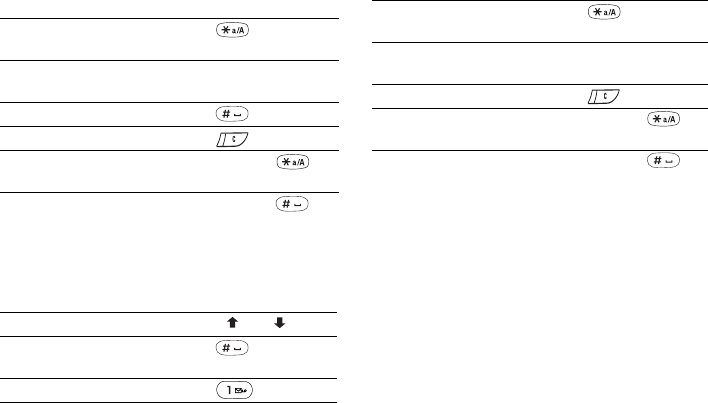
Getting to know your phone 11
Help texts
More information, explanations or tips about selected
menus or functions are available in your phone.
To get help
Select the menu or function and press Info.
shift between capital and
lower-case letters press , then
the letter
enter numbers press and hold any of
the number keys
enter a space press
delete letters and numbers press
shift between multitap or
T9 Text input methods press and hold
shift between input
languages (including
character or numeric)
press and hold
To... When entering letters
using T9 Text Input:
view alternative words press or
accept a word and add a
space press
enter a full stop/period. press
To... When entering letters
using multitap text
input: shift between capital and
lower-case letters press , then
the letter
enter numbers press and hold any of
the number keys
delete letters and numbers press
shift between multitap or
T9 Text input methods press and hold
shift between input
languages (including
character or numeric)
press and hold
To... When entering letters
using T9 Text Input:
T610UG-R3A.book Page 11 Tuesday, May 27, 2003 5:16 PM

12 Getting to know your phone
Delete and edit
If you add items, for example, a contact, a note, an
appointment or a WAP bookmark, you can delete or
edit them.
To delete an item
Select an item and press .
To edit an item
Select an item, press More, and choose from the list
of options.
Online services
Online services are customized services offered by
network operators, independent of mobile phones
and mobile phone manufacturers.
A SIM card which supports Online services works
in the same way as a normal SIM card. When you
have inserted your SIM card and turned on your
phone, your network operator can download data to
your SIM card. When you restart your phone after
the first data download, a new submenu appears
under the menu.
To enter your new menu system
Scroll to Connect, Online Services.
Note: This menu only appears if your SIM card
supports this service. Some operators may not use
the name “Online services”. Your phone may not
support all of the services offered.
T610UG-R3A.book Page 12 Tuesday, May 27, 2003 5:16 PM
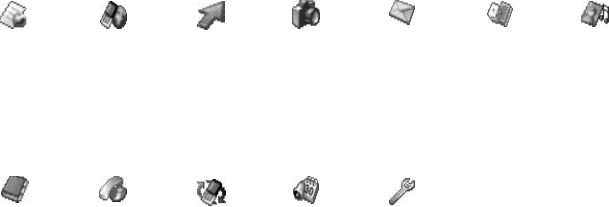
Getting to know your phone 13
Menu overview
Operator
direct link
Internet
Services
My Shortcuts Camera Messages Entertainment Pictures &
Sounds
(link to
operator’s
website)
Ring Volume
Select Profile
Switch to Line*
My Numbers
Edit Shortcuts
Te x t
MMS
Call Voicemail
Email
Chat
WAP Push
Area Info.*
Options
Games & More
Other Games
My Pictures
More Pictures
My Sounds
More Sounds
Themes
More Themes
Draw Picture
Music DJ
Record Sound
Phonebook Calls Connect Organizer Settings
Call
Manage SIM
Call Contact
Manage Contact
Pictures
Personal Rings
Voice Commands
Special Numbers
Advanced
Options
Missed Calls
Call List
Switch to Line*
Forward Calls
Manage Calls
Time & Cost
Next Call
Options
Online Services*
Bluetooth
Infrared Port
WAP Options
Synchronization
GSM Networks
Data Comm.
Accessories
Calendar
Notes
Alarms
Timer
Stopwatch
Calculator
Code Memo
Sounds & Alerts
Display
Profiles
Language
Time and Date
Voice Control
Locks
Handsfree
Master Reset
* Please note that
some menus/
icons are operator,
network and
subscription
dependent.
T610UG-R3A.book Page 13 Tuesday, May 27, 2003 5:16 PM
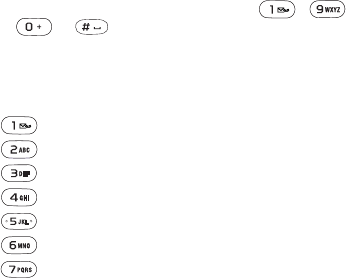
14 Getting to know your phone
Entering letters
You can enter letters, for example, when you add
names to the Phonebook, write text messages or
enter WAP addresses.
Apart from the way you normally enter letters in
your phone, using multitap text input, you can use
T9™ Text Input for entering text messages and
email, for example, if the input language you select
supports this. T9™Text Input is a predictive input
method and is a quicker way to write texts. See “T9
Text Input” on page 15.
Input languages
Before you start entering letters, you need to select
the input languages that you want to use when
writing.
To select input languages
1. Scroll to Settings, Language, Input.
2. Scroll to the language that you want to use for
entering letters and check each language you want.
3. Press Ok to exit the menu.
When writing, you can switch to one of your
selected input languages by pressing More and then
selecting Language. See “The list of options” on
page 16.
Multitap text input
When saving names in the Phonebook or when
writing WAP addresses, you enter letters using
multitap text input. You press each key as many
times as needed to show the letter you want. In the
following example, we are going to write a name in
the Phonebook.
To enter letters using multitap text input
1. Scroll to Phonebook, Manage Contact, Add Contact.
2. Press Add and then the appropriate key, – ,
or , repeatedly until the character you
want appears in the display.
See the table of the Latin alphabet below:
Press… to get…
". , - ? !’ @ : ; / ( )1
A B C Å Ä Æ à Ç 2 Γ
D E F è É 3 ∆ Φ
G H I ì 4
J K L 5 Λ
M N O Ñ Ö Ø ò 6
P Q R S ß 7 Π Σ
T610UG-R3A.book Page 14 Tuesday, May 27, 2003 5:16 PM
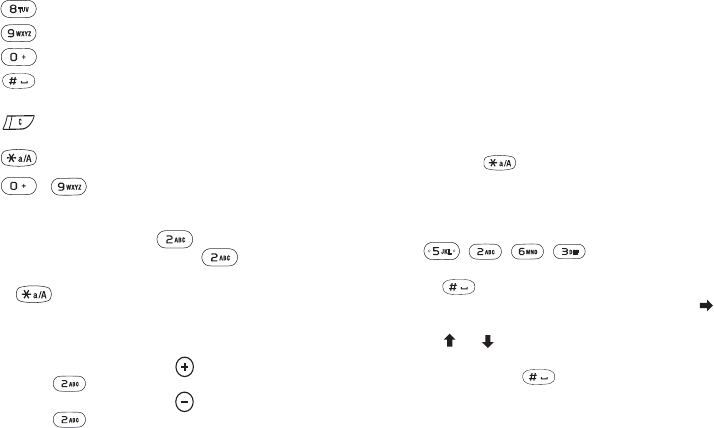
Getting to know your phone 15
Example:
• To enter an ‘A’, press once.
• To enter a ‘B’, quickly press twice.
• To shift between capital and lower-case letters, press
, then enter the letter.
Tip: You can also use the volume keys as a shortcut
to certain letters:
To enter a ‘B’, press the volume key and
press .
To enter a ‘C’, press the volume key and
press .
T9 Text Input
You can use T9™ Text Input when writing, for
example, text messages and email. The T9™ Text
Input method uses a built-in dictionary that
recognizes the most commonly used word for each
sequence of key presses. This way, you press each
key only once, even if the letter you want is not the
first letter on the key.
To shift from multitap to T9 text input method
Press and hold .
To enter letters using T9 Text Input
1. Scroll to Messages, Te x t, Write New.
2. For example, if you want to write the word “Jane”,
press , , , .
3. If the word shown is the one you want:
• press to accept and add a space.
(To accept a word without adding a space, press .)
If the word shown is not the one you want:
• Press or repeatedly to view alternative
words (candidates). Accept a word and add a
space by pressing .
T U V Ü ù 8
W X Y Z 9
+ 0
Space ↵ ¶
More for an options list
to delete letters and numbers
to shift between capital and
lower-case letters
- press and hold to enter numbers
Press… to get…
T610UG-R3A.book Page 15 Tuesday, May 27, 2003 5:16 PM
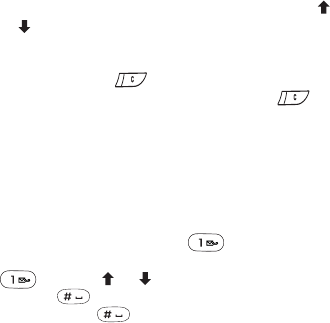
16 Getting to know your phone
If you do not find the word you want by pressing
or :
•Press
More to go to a list of options.
• Select Spell Word.
• Press and hold to delete the entire word,
or delete one letter at a time by pressing
repeatedly.
• Write the new word using multitap text input and
press Insert.
The word is added to the dictionary. The next time
you enter the word, it appears as one of the
alternative words.
4. Continue writing your message. See “Sending text
messages” on page 45. Press to enter a full
stop/period. To enter other punctuation marks, press
and then or repeatedly. Accept by
pressing .
Press and hold to select an input language.
The list of options
If you press More when writing, you enter a list of
options:
•Add Symbol – Symbols and punctuation marks such
as ? and, are shown. Move between the symbols by
using the joystick.
•Insert Item – Pictures, melodies and sounds.
•Spell Word – Change the suggested word by using
multitap text input.
•Text Format – Change style, size and alignment.
•Input Language– Change input language.
•Input Method – Change input method.
•Word suggestions – Select to show a list of suggested
words.
My Words – A list of words you have added to the
dictionary.
•Help.
T610UG-R3A.book Page 16 Tuesday, May 27, 2003 5:16 PM
Personalizing your phone 17
Personalizing your phone
You can adjust the phone settings to suit your own
requirements.
Note: If you change a setting which is included
in a profile, the active profile is also changed.
See “Profiles” on page 24.
Themes
You can change the appearance of the display, for
example, the colors and background picture, by
using themes. Your phone comes with some pre-set
themes. You can create new themes and download
them to your phone.
For more information, visit www.SonyEricsson.com
or wap.SonyEricsson.com.
To download a theme
1. Scroll to Pictures & Sounds, More Themes.
2. Select a link.
To send a theme
You can exchange themes via IR, Bluetooth wireless
technology, picture message or email. Please note
that you are not allowed to exchange copyright-
protected material. For more information on sending
themes in messages, see “Messaging” on page 45.
1. Scroll to Pictures & Sounds, Themes.
2. Select a theme, press More.
3. Select Send.
4. Select a transfer method.
To receive and save a theme
1. From standby, press more and select Turn On
Bluetooth or Turn On IR.
2. When you receive the theme, press Save to save it.
Pictures
Your phone comes with a number of pictures. You can:
• Download more pictures to your phone.
• Have a picture as wallpaper when in standby mode.
• Assign a picture to a contact in the Phonebook.
When that person calls, the picture appears in the
display (provided your subscription supports the
Calling Line Identification service). See “To add a
picture to a phonebook contact” on page 28.
• Insert a picture in a text message.
T610UG-R3A.book Page 17 Tuesday, May 27, 2003 5:16 PM

18 Personalizing your phone
All pictures are saved in My Pictures, in the Pictures
& Sounds menu.
You can also save animations in your phone. These
are handled like pictures.
Note: Animations must be in GIF format. Note that
not all image sizes are supported.
Handling pictures
You can add, edit, or delete pictures in My Pictures.
The number of pictures that can be saved depends on
the size of the pictures. File types supported are GIF,
JPEG and WBMP.
The pictures are shown in thumbnail view. To get
a full view, press View.
To view your pictures
Scroll to Pictures & Sounds, My Pictures.
To delete a picture
1. Scroll to or display the picture.
2. Press .
3. When prompted to delete the picture, press to
confirm.
Note: Pictures deleted from My Pictures are also
removed from your phonebook.
To download a picture
1. Scroll to Pictures & Sounds, More Pictures.
2. Select a link.
To turn wallpaper on or off
Scroll to Settings, Display, Wallpaper, Activate.
To set a picture as wallpaper
1. Scroll to Settings, Display, Wallpaper, Select
Picture, .
2. Select a picture to accept.
Tip: You can select Wallpaper by pressing More
when viewing pictures in My pictures.
Note: PC-based tools are available on
www.SonyEricsson.com.
To edit and save a picture
1. Scroll to Pictures & Sounds, My Pictures.
2. Scroll to the picture you want, More.
T610UG-R3A.book Page 18 Tuesday, May 27, 2003 5:16 PM

Personalizing your phone 19
3. Scroll to Edit. You can now start to edit the picture if
it is smaller than the screen size.
4. Press More, select Save Picture. The picture is saved
in My Pictures.
Note: To edit pictures taken with the camera, you
must select 120x160 as picture size.
To draw a picture
1. Scroll to Pictures & Sounds, Draw Picture.
2. Select a type.
3. Select Tool and choose the tool you want to work
with. Activate the tool by pressing the joystick.
When editing or drawing a picture:
Tip: Press and hold the key for continuous key
presses.
Note: Once you enlarge a picture, it will continue to
enlarge until you deactivate the feature.
Exchanging pictures
You can exchange pictures via IR, Bluetooth
wireless technology, MMS or email. Please note that
you are not allowed to exchange copyright-protected
material. For more information on sending pictures
in messages, see “Messaging” on page 45. Save the
email address of a WAP album in your Phonebook
and you can save pictures in that album if you send
the pictures as attachments.
To send a picture
1. Scroll to Pictures & Sounds, My Pictures. Scroll to
the picture you want, More.
2. Select Send.
Press… to…
navigate
activate the current drawing tool.
More view an options menu.
press and hold to exit the picture editor.
undo the last action.
select tool.
select a color.
Press… to…
T610UG-R3A.book Page 19 Tuesday, May 27, 2003 5:16 PM
20 Personalizing your phone
3. Select a transfer method.
If you use infrared make sure that the infrared ports
are facing each other.
To receive and save a picture
1. Scroll to Connect, Bluetooth, Turn On.
2. When you receive the picture, press Save to save it
in My Pictures.
When you receive a picture in a text message or a
picture message, a new message appears in your
Inbox. To save the picture in My Pictures, highlight
the picture by moving the joystick to select it and
press Save.
Screen saver
The phone has a screen saver, which is activated
automatically when the phone has been in idle mode
for a few seconds. After a few more seconds, the
screen saver changes to sleep mode to save power.
To turn the screen saver On or Off, scroll to Settings,
Display, Screen Saver, Activate.
To use a picture as the screen saver
You select a picture saved in the phone and use it as
the screen saver.
1. Scroll to Settings, Display, Screen Saver, Select
Picture.
2. Scroll to and select the picture you want to use as
the screen saver.
3. Press Select to accept.
Ring tones and melodies
Your phone comes with a number of ring tones and
melodies. You can edit your own ring tones and
melodies and send them to a friend in a text message.
It is also possible to exchange melodies via WAP,
Bluetooth wireless technology, IR or cable. Please
note that you are not allowed to exchange copyright-
protected material. You can also download ring
tones to your phone.
To select a ring tone
Scroll to Settings, Sounds and Alerts, Ring Sounds.
To download a ring tone
1. Scroll to Pictures & Sounds, More Sounds.
2. Select a link.
T610UG-R3A.book Page 20 Tuesday, May 27, 2003 5:16 PM

Personalizing your phone 21
To set the ring tone volume
1. Scroll to Settings, Sounds and Alerts, Ring Volume.
2. Press or to increase the volume. Press or
to decrease the volume.
3. Press Save to save the setting.
• To turn the ring tone on or off, press and hold
from standby.
All signals except the alarm and timer signals are
turned off.
To compose a ring tone or melody
1. Scroll to Pictures & Sounds, Music DJ.
2. Choose to insert a selection of pre-recorded music
blocks. You can choose from four different selections.
3. Copy and paste these blocks to build up your melody.
4. Select More to play the melody and view other options.
Note: To edit your own melody, scroll to Pictures &
Sounds, My Sounds, select the melody and press
More. Select Edit.
To send a melody
1. Scroll to Pictures & Sounds, My Sounds.
2. Scroll to a melody, More.
3. Select Send.
4. Select a transfer method.
Note: To send a ring tone or melody in a text
message, see “To insert an item in a text message”
on page 45.
Receiving melodies
You can receive a sound or melody via IR, Bluetooth
wireless technology, text, picture message, or
download it via WAP. When you receive the sound
or melody, press Save to save it in My Sounds.
Increasing ring
You can choose a ring tone that rises in steps from
the lowest volume to the highest.
To turn increasing ring On or Off,
Scroll to Settings, Sounds and Alerts, Increasing Ring.
Specific ring tones for personal calls
If you subscribe to the Two Line Service,
you can set different ring tones for the two
voice lines. Line 1 and Line 2 are displayed
instead of Voice Calls.
If your subscription includes the Calling Line
Identification (CLI) service, you can assign a
personal ring tone to up to ten callers.
T610UG-R3A.book Page 21 Tuesday, May 27, 2003 5:16 PM
22 Personalizing your phone
To set a specific ring tone for a caller
1. Scroll to Phonebook, Personal Rings, New Contact.
2. Select a contact.
3. Select a ring tone.
Sounds and alerts
You can choose to be notified of an incoming call by
the buzzing of the vibrating alert. You can set the
phone’s vibrating alert to one of the following:
•On – all the time.
•On If Silent – on when the ring volume is turned
off or when you have set the phone to silent.
•Off – all the time.
To set the vibrating alert
1. Scroll to Settings, Sounds and Alerts, Vibrating
Alert.
2. Select the setting you want.
From the Settings, Sounds and Alerts menu, you can
also select Message Alert, Key Sound and turn on the
Minute Minder.
If you turn on the minute minder, you hear a beep
once every minute during a call.
Menu language
Most SIM cards automatically set the menu language
to the language of the country where you bought
your SIM card. If this is not the case, the preset
language is English.
To change the menu language
1. Scroll to Settings, Language, Menus.
2. Select a language.
Display light
The display light can be set to automatic or on. In
automatic mode, the display light is turned off a few
seconds after your last key press.
• To set the display light, scroll to Settings, Display,
Light.
• To set the display contrast, scroll to Settings,
Display, Contrast.
Time settings
The time is always displayed in standby.
• To set the time, scroll to Settings, Time and Date,
Set Time.
You can choose a 12-hour clock or a 24-hour clock.
• To set the time format, scroll to Settings, Time and
Date, Time Format.
T610UG-R3A.book Page 22 Tuesday, May 27, 2003 5:16 PM

Personalizing your phone 23
Date
When the phone is in standby mode, you can press
a volume key up or down to see today’s date in the
Status menu.You can set the date and date format in
the Settings, Time and Date menu.
Advanced time settings
Under Advanced in the Settings, Time and
Date menu, you can set time zone and
daylight saving time. By changing these
you also change the time.
When your phone changes network, and the time
sent out from the operator deviates from the time in
your phone, you are asked whether you want to
update the time if you have turned on Auto Time
Zone. If you press Yes, the time is updated
automatically.
Answering mode
When using a portable handsfree kit, you can choose
to answer a call by pressing any key (except the No
key) or set the phone to answer the call automatically.
• To select answering mode, scroll to Settings,
Handsfree, Answering Mode.
Start-up picture
When you turn your phone on or off, the Sony
Ericsson start-up animation appears in the display
until fully powered on. Your operator’s own greeting
may be shown instead.
To select a start-up picture
1. Scroll to Settings, Display, Start-up Picture.
2. Select which start-up picture you would like.
3. Press to confirm.
My phone numbers
You can check your own mobile phone number(s).
• To check your phone number, scroll to Phonebook,
Special Numbers, My Numbers. If your number is
not saved on your SIM card, you can enter it
yourself.
Keypad lock
You can lock the keypad to avoid dialing a number
by accident.
Note: Calls to the emergency number 911 can still
be made, even when the keypad is locked.
T610UG-R3A.book Page 23 Tuesday, May 27, 2003 5:16 PM

24 Personalizing your phone
Automatic keylock
Automatic keylock means the keypad is locked
25 seconds after you last press a key.
• To lock the keypad manually, press More in standby,
and select * Lock keys.
The keypad remains locked until you answer an
incoming call or until you unlock the keypad manually.
• To unlock the keypad, press Unlock and then .
My shortcuts
You can place your favorite functions that you want
to reach quickly and easily in the My Shortcuts menu.
To add a function to my shortcuts
1. Scroll to My Shortcuts, Edit Shortcuts.
2. Select a function from the list by pressing Check.
3. Enter the position number you want for this function
in your menu and press Ok.
4. Press Save to exit the list.
Profiles
Your phone has a number of preset profiles which are
set to suit a certain environment. You can rename,
change and add accessories to these profiles. For
example, when you go to a meeting, you can simply
choose the Meeting profile and a number of settings,
such as the ring tone, is turned off.
• To select a profile, scroll to Settings, Profiles,
Select Profile.
To change a profile setting
1. Scroll to Settings, Profiles, Edit Profile.
2. Select a setting.
3. Change the profile settings and press Select to
confirm.
• To rename a profile, scroll to Settings, Profiles,
Edit Profile, Profile Name.
You can reset all profile settings to the way they
were set when you bought your phone.
• To reset all profiles, scroll to Settings, Profiles,
Reset Profiles.
Automatic activation
Some profiles, for example In car, are automatically
activated when used with a specific accessory. When
disconnected, the profile is changed back.
T610UG-R3A.book Page 24 Tuesday, May 27, 2003 5:16 PM

Calling 25
Master reset
You can reset all the settings in the phone to the way
they were when you bought your phone by selecting
Reset Settings.
If you also want to delete all contacts, messages
and other personal data, select Reset All instead.
To reset the phone
1. Scroll to Settings, Master Reset.
2. Select Reset Settings or Reset All.
Enter the phone lock code (0000 or the new code if
you have changed it) and press Ok.
3. If you are sure you wish to reset, press Yes to answer
the Continue? prompt. If unsure, press No and the
settings will remain unchanged.
Calling
Before you can make or receive any calls, you must
turn on the phone and be within range of a network.
See “Turning the phone on” on page 6.
Making calls
1. Enter the area code (if necessary) and the phone
number.
2. Press Call to make the call.
3. Press End Call to end the call.
Note: It is not necessary to dial "1" to make long
distance calls.
To change the earpiece volume during a call
Use the volume keys on the side of the phone to
increase or decrease the earpiece volume during a call.
To mute the microphone during a call
Press and hold until the display shows Muted.
Press and hold again to resume the
conversation.
T610UG-R3A.book Page 25 Tuesday, May 27, 2003 5:16 PM

26 Calling
Automatic redialing
If the connection of the call failed and the display
shows Retry?, press Yes. The phone re-dials the
number (up to ten times):
• Until the call is connected.
• Until you press a key or receive a call.
Note: Do not hold the phone to your ear while
waiting. When the call is connected, the phone
gives out a loud signal.
Automatic redialing is not available for fax and
data calls.
Making international calls
1. Press and hold until a + sign appears in the
display.
The + replaces the international prefix number of
the country from which you are calling.
2. Enter the country code, area code (without the
leading zero) and phone number, Call.
Making emergency calls
• Enter your emergency number, press Call.
Your phone supports the international emergency
numbers, 911, 112 and 08. This means that these
numbers can normally be used to make an emergency
call in any country, with or without a SIM card
inserted, if a GSM network is within range.
Note: Some network operators may require that a
SIM card is inserted, and in some cases that the PIN
has been entered as well.
In some countries, other emergency numbers may also
be promoted. Your operator may therefore have
saved additional local emergency numbers on the
SIM card.
• To view your local emergency numbers, scroll to
Phonebook, Special Numbers, Emergency Nos.
Receiving calls
When you receive a call, the phone rings and the
display shows Answer?.
If your subscription includes the Calling Line
Identification service and the caller’s number is
identified, the number is displayed. If you have
saved the number in the Phonebook, the name and
number are displayed. If you have assigned a picture
to a contact, the picture is displayed. If the number is
a hidden number, the display shows Withheld.
T610UG-R3A.book Page 26 Tuesday, May 27, 2003 5:16 PM

Calling 27
To answer a call
Press Yes.
To reject a call
Press No.
Note: The call will automatically be forwarded
to voicemail if it is set up through your service
provider.
Tip: You can also use your voice to answer or reject
calls. See “Voice control” on page 32.
Missed calls
If you have missed a call, Missed Calls:x appears in
standby. X indicates the number of missed calls.
To check your missed calls
1. Press Yes to display the missed calls.
2. To call a number from the list, scroll to the number,
Call.
Call list
The numbers of the last 30 calls that you have made
are saved in the call list. If your subscription includes
the Calling Line Identification service and the caller’s
number is identified, you will also find the numbers
of answered and missed calls in the call list.
To call a number from the call list
1. To enter the call list, press Calls from standby.
2. Scroll to the number you want to call, Call.
• To clear the call list, scroll to Calls, Options, Clear
Call List.
• To turn the call list on or off, scroll to Calls, Options,
Call Listing.
Call priority service
You can request a certain priority when you
make a call, if your subscription supports
the call priority service.
The priority levels are defined by your operator and
are normally within the range of 0 – 4, where 0 is the
highest priority.
T610UG-R3A.book Page 27 Tuesday, May 27, 2003 5:16 PM
28 Calling
To check or change your standard priority level
1. Scroll to Calls, Manage Calls, Default Priority.
2. The network sends available priority levels.
3. Select a priority level.
To change the priority for one call
1. Enter the phone number you want to call.
2. Scroll to Calls, Next Call, Next Outgoing Call.
3. Select a priority. The number is called.
Phonebook
In the Phonebook you can store the information on
your SIM card and on your phone. You have space
for up to 510 numbers. You can save all the information
needed to contact people. You can also set how much
information you want to show for your contacts.
Entries saved as contacts are stored in your phone’s
memory, not on your SIM card. To synchronize your
phone-based contact list with your PDA or PC, see
“Synchronization” on page 69.
To call a contact from your SIM card
1. Scroll to Phonebook, Call.
2. Enter the letter corresponding to the first letter of the
contact you want to find, Ok.
3. Select the number you want to call.
To set the fields in contact information
1. Scroll to Phonebook, Options, Contact Info.
2. Press Check/Uncheck to select or clear fields.
If your Phonebook is empty, you are prompted to
copy information from your SIM card. If you press
No, you can add new contacts. If you press Yes, your
contact list is copied from your SIM.
To add a contact
1. Scroll to Phonebook, Manage Contact, Add Contact.
2. Scroll to the field you want to fill in, Add.
3. Enter the information, Ok.
4. Select the next field and so on.
5. When you have entered the information, press Save.
Tip: To enter an unsaved number, press Lookup
when you are in a number field, and select a number
in the unsaved numbers list.
Pictures, personal rings and voice commands
You can add a picture, personal ring tone and voice
command to a contact.
To add a picture to a phonebook contact
1. Scroll to Phonebook, Pictures.
2. Enter the letter corresponding to the first letter of the
contact you want to find, Ok.
T610UG-R3A.book Page 28 Tuesday, May 27, 2003 5:16 PM

Calling 29
3. Scroll to the name, Ok.
4. This takes you to My Pictures. Select a picture, Yes.
•Select Personal Rings to add a personal ring tone.
•Select Voice Commands to add a voice command.
To call a contact from your contact list
1. From standby, press and hold one of the number
keys 2-9 to find a contact beginning with the first
letter on that key (or closest following).
• For example, press and hold 5 to go to the first
contact beginning with “J”. To go to a contact
beginning with “L” press 5 three times after you
have entered the list of contacts.
2. When the contact you want to call is highlighted,
press Select.
3. Select the number you want to call, Call.
Updating the phonebook
When needed, you can easily update or delete any
contact information.
To edit a contact
1. Scroll to Phonebook, Manage Contact, Edit Contact.
2. Enter the letter corresponding to the first letter of the
contact you want to find, Ok.
3. Scroll to the name, Edit.
4. Select Edit Information.
5. Scroll to the field you want to fill in, Edit.
6. Enter the information, Ok.
7. Select the next field and so on.
8. When you have entered the information, press Save.
To delete a contact
• Scroll to Phonebook, Manage Contact, Delete
Contact. Then select the contact and press Delete.
Tip: You can also delete a contact by pressing
when the contact is highlighted.
To delete all contacts
• To delete all contacts, scroll to Phonebook,
Advanced, Delete All?.
Note: Contacts that are saved on the SIM card are
not deleted.
Default (standard) number
Each contact has a default phone number. The first
phone number you link to a contact automatically
becomes the default number. If you scroll to a certain
contact in the Call Contact list and then press Call,
the default number is highlighted.
T610UG-R3A.book Page 29 Tuesday, May 27, 2003 5:16 PM
30 Calling
To set the default number
1. Scroll to Phonebook, Manage Contact, Edit Contact.
2. Enter the letter corresponding to the first letter of the
contact you want to find, Ok.
3. Scroll to the name, Edit.
4. Select Default Number. Highlight the number you
want as default, press Select.
Groups
You can create a group of contacts. By doing so, you
can send messages to several recipients at the same
time. See “Sending text messages” on page 45.
To create a group of contacts
1. Scroll to Phonebook, Manage Contact, Groups,
New Group, Add.
2. Enter a name for the group, Ok.
3. Select Add member.
4. Enter the letter corresponding to the first letter of
the contact you want to find, Ok.
5. Select the contact.
6. Select a phone number.
7. Repeat steps 3-6 to add more members.
Business cards
You can add your own business card to the
Phonebook.
• To add your own business card, scroll to Phonebook,
Manage Contact, My Card. Then select Add.
Exchanging business cards
You can exchange business cards between your
phone and another similar phone, a PDA or a PC,
using Bluetooth wireless technology, the infrared
port, text or picture message.
To send your business card
1. Scroll to Phonebook, Manage Contact, My Card,
Send.
2. Select a transfer method.
If you use infrared make sure that the infrared ports
are facing each other.
When you receive a business card via a text message,
you accept the card by pressing Yes. To be able to
receive a business card using the infrared port or
Bluetooth wireless technology, you need to turn these
functions on.
T610UG-R3A.book Page 30 Tuesday, May 27, 2003 5:16 PM
Calling 31
To receive a business card
1. From standby, press More and scroll to Turn On
Bluetooth or Turn On IR.
2. When you receive the business card, press Yes.
To send a contact
1. Scroll to Phonebook, Manage Contact, Send
Contact.
2. Enter the letter corresponding to the first letter of
the contact you want to find, Ok.
3. Scroll to the contact you want to send, Send.
4. Select transfer method.
If you use infrared make sure that the infrared ports
are facing each other.
To send all contacts
Scroll to Phonebook, Advanced, Send All and select
a transfer method.
Copy contacts
You can copy the contacts between your phone’s
memory and the SIM card. The number of phone
numbers that can be saved depends on the type of
SIM card.
To copy contacts to the SIM card
Scroll to Phonebook, Advanced, Copy to SIM.
Note: Everything on the SIM card is replaced.
To copy contacts to the phone
Scroll to Phonebook, Advanced, Copy From SIM.
Tip: When you have selected a contact on the
SIM card in the Call menu, you can copy it to
the phone by pressing More and then selecting
Copy to Phonebook.
Speed dialing
You can save the phone numbers that you want to
reach easily in positions 1-9 on your SIM card.
To call any of these phone numbers from
standby:
Enter the position number and press Call.
To change position numbers
1. Scroll to Phonebook, Advanced, Position List.
2. Select the phone number you wish to change.
T610UG-R3A.book Page 31 Tuesday, May 27, 2003 5:16 PM
32 Calling
3. Select the position to which you want to move the
phone number.
4. Repeat steps 2 and 3 to continue to move phone
numbers.
5. When you have finished, press Back.
Checking the memory
With the Memory status function in your Phonebook,
you can check how many positions you have left in
your memory for the phone, SIM, email and voice
commands.
To check the memory
Scroll to Phonebook, Advanced, Memory Status.
Voice control
With your phone, you can use your voice to:
• Voice dial – call someone by saying the name and
number type.
• Re-dial the last dialed number.
• Answer and reject calls when using a handsfree kit.
• Change profile.
• Record or listen to sound recordings by using voice
commands.
• Activate the voice control by saying a “magic word”.
You can save approximately 50 recorded words as
voice commands in the 40 seconds available. This
also depends on what is saved in the memory with
other functions. When recording, make sure you are
in a quiet environment and try to use short words.
Before voice dialing
You must first turn on the name dialing function and
record your voice commands.
To turn voice dialing on and record number
types
1. Scroll to Settings, Voice Control, Voice Dialing.
2. Select On. Now you are going to record a voice
command for each number type you use with your
Phonebook contacts, for example, “home” or “mobile”.
3. Instructions appear. Press Ok.
4. Select a number type, Select.
5. Add Voice? will appear. Press Yes.
6. Lift the phone to your ear, wait for the tone and say
the command that you want to record. The voice
command is played back to you.
7. If the recording sounds OK, press Yes to save the
voice command. If not, press No and repeat step 4.
8. Repeat steps 4 and 7 for each voice command you
need.
T610UG-R3A.book Page 32 Tuesday, May 27, 2003 5:16 PM
Calling 33
You also need to record voice commands for each
contact name, for example, “John”.
To record a voice command for a contact name
1. Scroll to Settings, Voice Control, Voice Dialing, Edit
Names, Add Voice.
2. Enter the letter corresponding to the first letter of the
contact you want to find, Ok.
3. Select a contact.
4. Follow the instructions in the display.
An icon appears next to a contact name that has a
voice command.
Caller name
You can choose whether you want to hear the recorded
contact name when you receive an incoming call
from that contact.
• To turn the caller name On or Off, scroll to Settings,
Voice Control, Caller Name.
Voice dialing
You can voice dial by saying a pre-recorded word.
To m ake a c all
1. From standby, press and hold a volume key for
one second.
2. Lift the phone to your ear, wait for the tone and say
a name, for example “John”. The name is played
back to you.
3. If you have several numbers for that contact, after
a second tone, say the number type, for example,
“home”.
The number type is played back to you, and the call
is connected.
From standby, you can also initiate voice dialing, voice
profiles and voice control of sound recordings by:
• Pressing and holding a volume key.
• Pressing the handsfree button (when using a
portable handsfree or a Bluetooth headset).
• Saying the magic word. See “The magic word” on
page 34.
Redialing
You can use your voice to redial the last dialed
number, if you record a voice command for redialing.
T610UG-R3A.book Page 33 Tuesday, May 27, 2003 5:16 PM
34 Calling
To turn on and to record a redial command
1. Scroll to Settings, Voi c e C on trol , Voice Redial.
2. Select On.
3. Instructions appear. Press Ok.
4. Lift the phone to your ear, wait for the tone and say
“Redial”, or another word. If the recording sounds
OK, press Yes. If not, press No and repeat step 3.
To redial using a voice command
1. From standby, press and hold a volume key for one
second.
2. Lift the phone to your ear, wait for the tone and say
“Re-dial”. The voice command is played back to you
and the last dialed number is called.
Voice answering
You can answer or reject incoming calls by using
your voice, when using a portable handsfree or a car
handsfree kit.
To turn on voice answering and record voice
answer commands
1. Scroll to Settings, Voi c e C o n t ro l , Voice Answer.
2. Select On.
3. Select the accessories you want to be able to use with
voice answering by pressing Check and then Save.
4. Instructions appear. Press Ok.
5. Lift the phone to your ear, wait for the tone and say
“Answer”, or another word. If the recording sounds
OK, press Yes. If not, press No and repeat step 5.
6. Lift the phone to your ear, wait for the tone and say
“Busy”, or another word. If the recording sounds
OK, press Yes. If not, press No and repeat step 6.
To answer a call using voice commands
When the phone rings, say “Answer”.
The call is connected.
To reject a call using voice commands
When the phone rings, say “Busy”.
The call is rejected. The caller is forwarded to
voicemail, if turned on, or hears a busy tone.
The magic word
You can record a magic word and use it as a voice
command to allow total handsfree access to voice
control. Instead of pressing a volume key, you say
the magic word and then one of your recorded voice
commands. The magic word is especially suitable
when using a car handsfree kit.
T610UG-R3A.book Page 34 Tuesday, May 27, 2003 5:16 PM
Calling 35
Tip: Choose a long, unusual word which can easily
be distinguished from ordinary background speech.
To turn on and record the magic word
1. Scroll to Settings, Voi c e C o n t ro l , Magic Word.
2. Select On.
3. Select the accessories you want to be able to use with
the magic word by pressing Check and then Save.
4. Instructions appear. Press Ok.
5. Press Ok again.
6. Lift the phone to your ear, wait for the tone and say
the magic word.
Tip: Turn off the magic word when you no longer
need total handsfree access in order to save battery
power.
Changing profiles
If you record voice commands for your profiles, you
can change profile with your voice.
To turn on and record profile commands
1. Scroll to Settings, Voi c e C o n t ro l , Vo i c e P ro f i l es .
2. Select On.
3. Instructions appear. Press Ok.
4. Select a profile.
5. Add Voice? will appear. Press Yes.
6. Lift the phone to your ear, wait for the tone and say
the profile name. Repeat steps 4 and 6 to record
voice commands for the other profiles.
To change a profile using voice commands
1. From standby, press and hold a volume key for
one second.
2. Lift the phone to your ear, wait for the tone and
say the profile command for the required profile.
The profile command is played back to you and
the current profile is changed.
Sound recordings
Instead of using the menus, you can record voice
commands to start or to listen to a recording.
To turn on and record recording commands
1. Scroll to Settings, Voice Control, Sound Recorder.
2. Select On.
3. Instructions appear. Press Ok.
4. Lift the phone to your ear, wait for the tone and say
“Record”, then press Yes.
5. Lift the phone to your ear, wait for the tone and say
“Play”, then press Yes.
T610UG-R3A.book Page 35 Tuesday, May 27, 2003 5:16 PM
36 Calling
To start a recording using a voice command
1. From standby, press and hold a volume key for one
second.
2. Lift the phone to your ear, wait for the tone and say
“Record”. The voice command is played back to you
and a tone indicates that the recording has begun.
3. To end the recording, press Stop.
To listen to recording using a voice command
1. From standby, press and hold a volume key for one
second.
2. Lift the phone to your ear, wait for the tone and say
“Play”. The voice command is played back to you.
3. Listen to your recordings. Press Stop to stop.
Editing your voice commands
You can keep all your voice commands up to date
by re-recording them or deleting the ones you do not
use. See the following example:
To re-record a voice command
1. Scroll to Settings, Voi c e C o n t ro l , Vo i c e P ro f i l es ,
Edit Commands.
2. Select a voice command.
3. Select Replace Voice.
To listen to a recorded voice command, select
Play Voice.
4. Lift the phone to your ear, wait for the tone and say
the command.
You can also edit the voice command for a contact
name in Phonebook, Manage Contact, Edit Contact.
Tips when recording and using voice
commands
If your phone cannot detect speech, one of the
following might have happened:
• You spoke too softly – try speaking louder.
• You held the phone too far away – hold it as you do
during a call.
• The voice command was too short – it should be
around one second long and more than one syllable.
• You spoke too late or too soon – speak immediately
after the tone.
• You did not record the voice command when the
handsfree was attached – for voice control with a
handsfree kit, record when the handsfree is attached.
• You used another intonation – use the same intonation
as you did when recording the voice command.
T610UG-R3A.book Page 36 Tuesday, May 27, 2003 5:16 PM
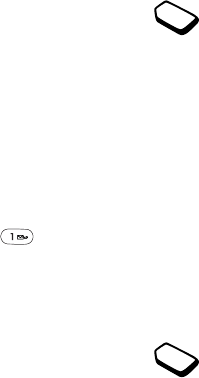
Calling 37
Voicemail
If your subscription includes an answering
service, callers can leave a voicemail
message when you cannot answer a call.
Receiving a voicemail message
Depending on your network operator, you are
informed that someone has left a message by a text
message or by a voicemail indication. Press Yes to
read the message.
Calling your voicemail service
You can easily call your voicemail service by
pressing and holding , if you have saved your
voicemail number in the phone. You get the number
from your service provider.
• To enter the number, scroll to Messages, Options,
Voice Mail Number
Call time and cost
During a call, the duration of the call is
shown in the display. If you subscribe to
cost information, the call cost (or the number
of call units) is displayed.
You can check the duration of your last call,
outgoing calls and the total time.
• To check the call time, scroll to Calls, Time & Cost,
Call Timers and select an option. To reset the call
time meter, select Reset Timers.
You can check the cost of your last call and the total
cost of your calls.
• To check the call cost, scroll to Calls, Time & Cost,
Call Costs and select an option. To reset the call cost
meter, select Clear Total Cost.
Note: If you subscribe to cost information, you must
enter your PIN2 to clear the cost or time counter.
Setting the call cost
You can use the Tariff function to specify the price
per call unit. If you do not specify a price per call
unit, the number of call units appears.
To enter the price per call unit
1. Scroll to Calls, Time & Cost, Call Costs, Set Tariff.
2. Enter your PIN2, Ok.
3. Select Change, Ok.
T610UG-R3A.book Page 37 Tuesday, May 27, 2003 5:16 PM

38 Calling
4. Enter the code for the currency you want, (for example
USD for U.S. Dollars), Ok.
5. Enter the price per call unit, Ok.
To enter a decimal point, press .
Credit limit for calls
You can enter a total amount of money
that can be used for making calls. When the
amount reaches zero, no more calls can be
made. Please note that the credit limit is only
an estimated value.
To set a credit limit
1. Scroll to Calls, Time & Cost, Call Costs, Set Credit.
2. Enter your PIN2, Ok.
3. Select Change, Ok.
4. Enter an amount, Ok.
Forwarding calls
If you cannot answer incoming voice, fax
or data calls, you can forward them to
another number, for example your
answering service.
For voice calls, you can choose between the
following forward alternatives:
•Forward Always – forward all voice calls.
•When Busy – forward calls if you are already on
the phone.
•Not Reachable – forward calls if your phone is
turned off or if you are unreachable.
•No Reply – forward calls that you do not answer
within a specified time limit (operator-dependent).
Note: When the Restrict Calls function is on, some
Forward Calls options cannot be activated. For
more information on restricting calls, see
“Restricted dialing” on page 42.
To turn on Call Forward
1. Scroll to Calls, Forward Calls.
2. Select a call category and then a forward alternative.
3. Select Activate.
4. Enter the phone number to which you want your
calls to be forwarded and press Ok, or retrieve it
from the Phonebook. When the icon is displayed,
Call forward it turned on.
To turn off Call Forward
To turn off a call forward, select a forward option
and select Cancel.
T610UG-R3A.book Page 38 Tuesday, May 27, 2003 5:16 PM

Calling 39
To check status
• Scroll to Calls, Manage Calls, Forward Calls. Select
a call type. Scroll to the forward you want to check.
Select Get Status.
• To check the status of all call forwards, select Check
All in the Forward Calls menu.
More than one call
You can handle more than one call
simultaneously. For example, you can put
an ongoing call on hold, while you make or
answer a second call, and then switch between
the two calls.
Call waiting service
If the call waiting service is on, you hear a beep in
the earpiece if you receive a second call during an
ongoing call.
• To turn the call waiting service on or off, scroll to
Calls, Manage Calls, Call Waiting.
To make a second call
1. Press Hold to put the ongoing call on hold.
2. Enter the number you want to call and press Call,
or retrieve a number from the Phonebook.
Note: You can only put one call on hold.
Receiving a second call
• To answer the second call and put the ongoing call
on hold, press Answer.
• To reject the second call and continue the ongoing
call, select Busy.
• Select Release & Answer to answer the second call
and to end the ongoing call.
Handling two calls
When you have one ongoing call and one call on
hold, you can do the following:
• Press Switch Calls to switch between the two calls.
• Press the center of the joystick and then select Join
Calls to join the two calls into a conference call.
• Press the center of the joystick and then select
Transfer Call, to connect the two calls. You are
disconnected from both calls.
• Press End Call to end the ongoing call, then press the
right softkey twice.
• Press End Call twice to end both calls.
Note: You cannot answer a third call without ending
one of the first two calls.
T610UG-R3A.book Page 39 Tuesday, May 27, 2003 5:16 PM

40 Calling
Conference calls
In a conference call, you can have a joint
conversation with up to five other people.
You can also put a conference on hold and
make another call.
Note: There may be additional charges for calls
involving multiple parties. Contact your service
provider for more information.
Creating a conference call
To create a conference call, you must first have one
ongoing call and one call on hold.
To join the two calls into a conference call
• Press the center of the joystick, Yes, Join Calls, Yes.
To add a new participant
1. Press Hold to put the conference call on hold.
2. Call the next person you wish to include in the
conference call.
3. Press the center of the joystick, select Join Calls, Yes.
Repeat steps 1 to 3 to include more participants.
To release a participant
1. Press the center of the joystick, select Release Part,
Yes.
2. Select the participant and press Select.
To end the conference call
• Press End Call.
Having a private conversation
You can have a private conversation with one of the
participants and put the other participants on hold.
• Press the center of the joystick, then select Extract
Part to select the participant that you want to talk
with.
• Select Join Calls to resume the conference call.
Two voice lines
Your phone may have two voice lines
with different phone numbers. This may
be useful if, for example, you want to keep
business and private calls on separate lines.
• To select a line, scroll to Calls, Next Call.
T610UG-R3A.book Page 40 Tuesday, May 27, 2003 5:16 PM

Calling 41
All outgoing calls are made on this line until you
change it. Incoming calls can still be received on
either line.
You can change the names of the lines, and have
different settings for each line, for example, different
ring tones.
• To change the name of a line, scroll to Settings,
Display, Edit Line Tags.
Calling card calls
You can use the calling card service to
redirect the cost of a call to a credit card or
a calling card account, instead of your normal
account. This may be useful, for example, when
making long distance calls.
You can save two separate calling card numbers.
The numbers and the codes associated with them are
protected by the phonelock code.
Before making a calling card call, you need to select
and activate a card.
Note: You cannot use the calling card service for fax
and data calls.
To turn the calling card service on or off
1. Scroll to Calls, Time & Cost, Calling Cards, Use
Calling Cards.
2. Enter your phonelock code, Ok (the default phone
lock code is 0000).
3. Select On or Off, Ok.
To save a card number
1. Scroll to Calls, Time & Cost, Calling Cards,
My Cards.
2. Enter your phonelock code, Ok.
3. Select New Card.
Enter the card settings (the access number and name
of the calling card server, and the verification code).
You get this information from your card provider.
Select which you want to send first – the number that
you want to call, or the verification code.
To select a card
1. Scroll to Calls, Time & Cost, Calling Cards,
My Cards.
2. Enter your phone lock code, Ok.
3. Select a card.
4. Select Activate Card.
T610UG-R3A.book Page 41 Tuesday, May 27, 2003 5:16 PM

42 Calling
To make a calling card call
1. Enter the phone number of the person you want to
call or retrieve the number from the Phonebook.
2. Press More and select Use Calling Cards.
The access number of the calling card server is
called. During the connecting phase, you are asked
to send the phone number you want to call and the
verification code.
3. Press Yes when the display shows Send Called
Number?, or wait a few seconds and the number
and code are sent automatically.
Restricted dialing
You can use the restrict calls service to
restrict outgoing and incoming calls. This
may be useful, for example, when you are
abroad. To use this service, you need a password
which you get from your service provider.
Note: If you forward incoming calls, you cannot
activate some Restrict Calls options.
The following calls can be restricted:
•All Outgoing – All outgoing calls.
•Outgoing Intl – All outgoing international calls.
•Outg. Intl Roam – All outgoing international calls
except to your home country.
•All Incoming – All incoming calls.
•Inc When Roam – All incoming calls when you are
abroad (when roaming).
Fixed Dialing
The fixed dialing function allows calls to be
made only to certain numbers saved on the
SIM card. Fixed dialing requires a SIM
card that allows fixed numbers to be saved. The
fixed numbers are protected by your PIN2.
Note: Calls to the emergency numbers can still be
made, even when the fixed dialing function is on.
• Partial numbers can be saved. For example, saving
0123456 allows calls to be made to all numbers
starting with 0123456.
• Numbers with question marks can be saved. For
example, saving 01234567?0, allows calls to be
made to numbers from 0123456700 to 0123456790.
To enter a question mark, press and hold .
T610UG-R3A.book Page 42 Tuesday, May 27, 2003 5:16 PM

Calling 43
To turn fixed dialing on or off
1. Scroll to Phonebook, Options, Fixed Dialing.
2. Enter your PIN2, Ok.
3. Select On or Off.
• To save a fixed number, scroll to Phonebook, Special
Numbers, Fixed Numbers. Select New Number and
enter the information.
Closed user groups
The Closed User Group function is a way of lowering
call costs. On some networks it is cheaper to make
calls within a call group. You can save ten groups.
To activate a group
1. Scroll to Calls, Manage Calls, Closed Groups,
Edit list.
2. Select a group.
3. Select Activate.
Calls can only be made within the selected group.
• To call outside a Closed User Group, select Calls,
Manage Calls, Closed Groups, Open Calls and
then select On.
Accept calls
With the accept calls service, you can choose to
receive calls only from certain numbers. Other calls
are automatically rejected by a busy tone. The phone
numbers of calls you have rejected are saved in the
Call List.
To add numbers to the accepted callers list
1. Scroll to Calls, Manage Calls, Accept Calls,
Accepted List.
2. Scroll to New, Add.
This takes you to the Phonebook or Groups.
3. Select an entry.
• To select an accept option, scroll to Calls, Manage
Calls, Accept Calls, Accept Options.
Networks
When you turn on the phone, it
automatically selects your home network if
this is within range. If it is not within range,
you may use another network, provided your
network operator has an agreement that allows you
to do so. This is called roaming.
T610UG-R3A.book Page 43 Tuesday, May 27, 2003 5:16 PM

44 Calling
You can select the network you want to use, or
you can add a network to your list of preferred
networks. You can also change the order in which
networks are selected during an automatic search.
For all such options, scroll to Connect, GSM
Networks.
Tone signals
You can use telephone banking services or
control an answering machine by sending
tone signals (also known as DTMF tones or
touch tones) during a call.
• To send the tones, press the number keys 0-9,
and .
• To clear the display after the call is finished,
press .
• To enter a pause, press 7.
Notepad
You can use the phone to make a note of a phone
number during a call. When you press the number
keys, the person you are talking to hears tone
signals. To turn these tone signals off during the call,
press the center of the joystick and select Turn Off
Tones. When you end the call, the number remains
in the display. You can then call the number by
pressing Call.
Showing or hiding your number
If your subscription supports the Calling
Line Identification Restriction (CLIR)
service, you can hide your phone number
when making a call.
To show or hide your phone number
1. Enter the phone number you want to call.
2. Press more and select Call and Hide ID or
Call and Show ID.
T610UG-R3A.book Page 44 Tuesday, May 27, 2003 5:16 PM
Messaging 45
Messaging
Your phone supports various messaging services - text
messaging (SMS), chat messaging, multimedia and
email. Please contact your service provider for details
of which services you can use. For more information
about text, see “Entering letters” on page 14.
Text messaging
Text messages can be sent to one person, several
recipients or to a group of recipients that you have
saved in the Phonebook. See “Groups” on page 30.
Text messages can also contain pictures, animations,
melodies and sounds.
Before you start
• First make sure that the number of your service
center is set. The number is supplied by your service
provider and is usually saved on the SIM card.
To set the service center number
1. Scroll to Messages, Text, Options, Service Centers.
If the service center number is saved on the SIM
card, it appears in the display.
2. If there is no number in the list, select Add New?, Add.
3. Enter the number, including the international “+” sign
and country code, Ok.
Sending text messages
For information about entering letters, see
“Entering letters” on page 14.
To write and send a text message
1. Scroll to Messages, Te x t, Write New.
2. Write your message, Continue.
3. Enter the recipient’s phone number, or retrieve a
number or a group from the Phonebook by pressing
Lookup.
4. Press Send.
Note: If you send a text message to a group, you
are charged for each member of that group.
To insert an item in a text message
1. Scroll to Messages, Te x t, Write New.
2. While writing your message press More.
3. Select Insert Item.
4. Select Picture, Sound Effect, Melody, Animation or
Picture (other).
5. Select an item, yes.
T610UG-R3A.book Page 45 Tuesday, May 27, 2003 5:16 PM

46 Messaging
Text formatting
You can change the style (bold, italics, etc.), size and
alignment of the text, and create new paragraphs, in
a text message.
To format the text in a text message
1. Scroll to Messages, Text, Write New.
2. Write the text message. Press More.
3. Select Text F o r m a t. Then select Text Size, Text Style,
Alignment or New Paragraph.
4. Select a text format, Ok.
Receiving text messages
When you receive a text message, the phone gives
you an audible signal and the message Read Now?
appears in the display.
Press Yes to read the text message, or No if you
want to read the message later. You may not receive
all parts of a long message at the same time.
• While reading the text message you can, for example,
start a chat session with the sender or go to a WAP
address found in the text message.
When you have read the text message, press More to
view a list of options.
Press to close the text message.
Calling a number in a text message
You can call a phone number that appears in a text
message.
• Select the phone number using the joystick, Call.
Saving incoming text messages
Incoming text messages are saved in the phone
memory. When the phone memory is full, incoming
text messages can be saved on the SIM card.
Messages that you have saved on the SIM card
remain there until you delete them.
To save from a text message
When the phone number, WAP address, picture,
animation or melody is highlighted, press More.
Then select Save.
• A picture or animation is saved in My Pictures.
• A melody is saved in My Sounds.
• A phone number is saved in Phonebook.
• A WAP address is saved in Bookmarks.
Long messages
A text message can contain up to 160 characters.
You can send a longer message by linking two or
more messages. Please note that you are charged for
each message within a linked message.
T610UG-R3A.book Page 46 Tuesday, May 27, 2003 5:16 PM

Messaging 47
• To turn long messages on, select Long Messages from
the Messages, Text , Options menu, then select On.
Note: Check with your service provider for the
maximum number of messages that can be combined
to form one long message.
Templates
If you have one or more messages that you send often,
you can save these as templates. There are five pre-
defined templates in your phone, but you can also
create your own.
To create a template
1. Scroll to Messages, Text, Templates, New Template,
Add.
2. Write the message, Ok.
3. Press Yes if you want to send the message now.
Press No to save the template.
Message options
You can set a default value for the message options
below, or you can turn on the Set on send option
which means that you choose the settings each time
you send a message.
• SMS Type – The phone supports different types of
messages. Your service provider may offer the facility
of converting a text message into a format (email or
fax, for example) that suits the equipment that is going
to receive the message.
•Status Request – Check if a message has been
delivered.
To set a default message option
1. Scroll to Messages, Te x t, Options.
2. Select an option.
To turn set on send on or off
Repeat steps 1 and 2 above, then select Set On Send.
To check the status of a sent message
Scroll to Messages, Te x t, Sent Items, select a text
message, View Status.
Picture Messages
Picture messages can contain text, pictures
and sounds and are sent via MMS
(Multimedia Messaging Service). You must
have a subscription that supports MMS or use a 3rd
party MMS provider. The recipient must also have
T610UG-R3A.book Page 47 Tuesday, May 27, 2003 5:16 PM
48 Messaging
an MMS-enabled subscription. Picture messages
can be sent to a mobile phone and email account.
You can also send contacts, calendar entries, sound
recordings and notes as attachments.
Before you start
Before sending a picture message, make sure that:
• The number to your service center is set. To set the
message server number, scroll to Messages, MMS,
Options, Message Server.
• You have entered the WAP settings. Scroll to
Messages, MMS, Options, WAP Profile and select
Select or Create New. To create a WAP profile, see
“Setting up WAP and Email” on page 56. Your
operator can automatically download all the settings
you need.
To compose and send MMS
1. Scroll to Messages, MMS, Create New.
The following options appear:
•Picture – From My Pictures.
•Text – Write a message.
•Sounds – From My Sounds.
•Camera – From the Camera.
•Recording – Record a message to accompany
the picture.
•Page – Start a new page.
2. Select an option.
3. Press Add to continue composing the message.
4. Press More for the following options:
•Send – Send the message.
•Preview – View the message before sending.
•Preview Page – View the page in the message.
•Page Timing – Set the duration in seconds that the
page will be shown on the recipient’s display.
•Background – Set the background color.
•Delete Page – Remove a page.
5. Select Send.
6. Enter a recipient’s phone number or press Lookup to
retrieve it from the phonebook.
7. Press Send.
Note: If you entered the number manually, press
proceed to go to “Advanced send options”.
Send options
Before sending MMS, you can set different options.
• To edit an option, scroll to Messages, MMS,
Options.
T610UG-R3A.book Page 48 Tuesday, May 27, 2003 5:16 PM
Messaging 49
Advanced send options
You can enter more information to accompany the
message as follows:
•To: – Phone number or email address. These can
be selected from the Phonebook.
•Subject: – Write a title, Yes.
•Cc: – Phone number or email address.
•Bcc: – Phone number or email address.
•Attachments: – Add your own card, a business
card or a melody from My Sounds.
•Priority: – High, normal, low.
•Delivery Report: – Turn on or off.
•Read Report: – Turn on or off.
Tip: You can base your message on one of the pre-
defined templates.
To use a pre-defined template for a picture
message
1. Scroll to Messages, MMS, Temp l a t es.
2. Select a template and press Add to make changes.
Receiving picture messages
When you receive a picture message, the phone
beeps and the message Read now? appears in the
display. Press Yes to read the message.
Note: You can receive and store a maximum of
20 messages. You may have to delete old messages
before you can receive new ones.
Restrict messages
From the Messages, MMS, Options, Restrict Msg,
Home Network or Roaming Net. select one of the
following:
•Allow – Your phone automatically downloads
messages to your phone as soon as they come to
your operator’s server. This is default.
•Always Ask – You will be prompted to download or
to keep it on the server.
•Restrict – New messages appear in the box as icons.
No prompt is received with the message.
• From the Messages, MMS, Options, Restrict Msg,
Filter, select the type of message you want to reject
automatically:
• Advertisements
• Anonymous
T610UG-R3A.book Page 49 Tuesday, May 27, 2003 5:16 PM

50 Messaging
Mobile chat
The mobile chat function works in the same way as a
chat on the Internet. You can choose a nickname that
will appear in the recipient’s display each time you
send a chat message.
Note: This feature is operator dependent.
To enter a chat nickname
1. Scroll to Messages, Chat.
2. Select Nickname.
3. Enter your nickname (maximum of 6 characters), Ok.
To start a chat session
1. Scroll to Messages, Chat, Start New.
2. Enter the recipient’s phone number, or retrieve it from
the Phonebook by pressing Lookup.
3. Write your message, Send.
Receiving a chat session invitation
When you receive a chat session invitation, the
phone gives you an audible signal and the message
Chat Message Chat Now? appears in the display.
• To read the chat message, press Yes.
• Write your chat message reply and press Send.
• To suspend a chat session, press .
• To resume a chat session, scroll to Messages, Chat,
Resume
• To end a chat session, scroll to Messages, Chat, End.
• To reject a chat message, press No.
If you receive a new chat message while another
chat session is ongoing, press Yes to end the
ongoing session and start the new one.
Area information
Area information is a type of text message
(for example, a local traffic report) that is
sent to all subscribers in a certain network
area. When you receive an area information
message, the message automatically appears in
the display. You cannot save area messages. Please
consult your service provider for more information
about area information codes.
• To turn area information on or off, scroll to Messages,
Area Info., Reception.
• To enter an area information code, scroll to
Messages, Area Info., Message List, Add New?
T610UG-R3A.book Page 50 Tuesday, May 27, 2003 5:16 PM
Messaging 51
Cell information
The cell information channel is used by some network
operators to send messages to their subscribers
within a certain network area.
• To turn on the channel, scroll to Messages, Area Info.,
Cell Information.
Email
You can use your phone to send and receive email
messages. Please note that you need a subscription
that supports data transmission. For more information,
consult your service provider.
Before you start
First make sure that you have:
• Set up a data account. See “Data account” on page 58.
• Set up and select an email account. See “Email
account settings” on page 62.
Sending and receiving email messages
The Send And Receive option offers the fastest way
to send email messages saved in the Outbox and to
check for new email messages.
To write and send an email message
1. Scroll to Messages, Email, Write New.
2. Select:
•To: – Then add name, enter an email address, or
retrieve an email address from the Phonebook. To
retrieve a saved address from the Phonebook or
received messages in your inbox, press Lookup
and select either Phonebook or Archive. When
you have finished adding recipients, press No to
return to writing an email message.
•Cc: – If you want to send a copy of the message
to someone.
•Priority: – Set the message priority.
•Subject: – Write a title, Ok.
•Text : – Write your message, Ok.
•Attachments: – Add pictures to a message.
To retrieve a number from the phonebook or archive
press Lookup.
When you have finished, press Done.
3. Select one of the following:
•Send Now – The email message is sent.
•Send W. Attach. – You can attach a picture from
My Pictures or from a digital camera connected
via IR. Select a picture and press Send.
T610UG-R3A.book Page 51 Tuesday, May 27, 2003 5:16 PM
52 Messaging
•Save to Outbox – The email message is saved in
the Outbox.
•Save to Drafts – The email message is saved in
the Drafts folder.
•Send And Receive in the Email menu – All email
messages in the Outbox are sent.
Note: Attachments are not saved to the Drafts folder
and must be re-inserted before sending.
To receive and read email messages
1. Scroll to Messages, Email, Send And Receive
2. When the email messages have been downloaded to
the phone, scroll to Messages, Email, Inbox to read
them.
Note: The phone can save up to six complete email
messages depending on size or you can download
headers only. See “Email account settings” on
page 62. All email messages are also saved on your
email server.
An arrow in the top or bottom right corner indicates
that there are more messages on the server.
To reply to an email message
1. Open the email message.
2. Place the cursor in the text and press More.
3. Select Reply or Reply All.
4. Select Write New or Include This Msg to include
the received message.
5. Write a message.
To save an email address or a phone number
• When the email address or phone number is
highlighted, select Save.
Archiving
You can archive an email message in order to read
it later. You can archive only as much text as the
display shows.
To archive an email message
1. Open the email message.
2. Make sure that the text you want to archive is visible
in the display.
3. Place the cursor in the text and press More.
4. Select Copy to Archive The text can be found in the
Archive submenu.
T610UG-R3A.book Page 52 Tuesday, May 27, 2003 5:16 PM
Camera 53
To delete an email message (POP3 users)
1. Scroll to Messages, Email, Inbox.
2. Scroll to the message and press More.
3. Select Mark To Delete. The message is deleted the
next time you connect to your email server by
selecting Send & receive.
To delete email messages (IMAP4 users)
1. Scroll to Messages, Email, Inbox.
2. Scroll to the message and press More.
3. Select Mark To Delete The message is marked for
deletion on the server.
4. Select Empty Inbox.
5. The message is deleted the next time you connect to
your email server by selecting Send And Receive.
Camera
Your mobile phone has a digital camera. You can
take pictures and send them as picture messages.
To do this, you need a subscription that supports this
service. Please check with your network operator.
You can also use a picture as a screen saver or as
wallpaper, or save it together with a contact in your
phonebook so that the picture appears when that
person calls. See “To add a picture to a phonebook
contact” on page 28.
T610UG-R3A.book Page 53 Tuesday, May 27, 2003 5:16 PM
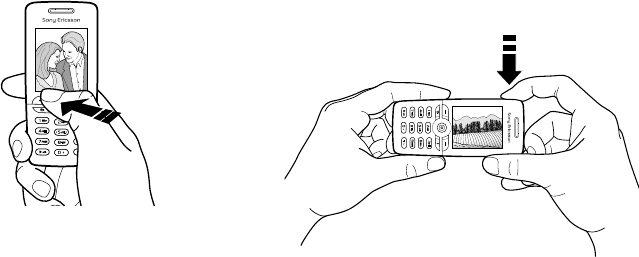
54 Camera
Taking pictures
There are different ways to take a picture. You can
scroll to Camera and hold the phone as shown in
the illustration. You can see the subject in the phone
display. Press Capture to take the picture.
Tip: For best results, hold the phone still for
1 second during capture mode.
Press the camera button on the side of the phone
to activate the camera. Hold the phone as shown in
the illustration. You can see the image in the phone
display. Press the camera button again to take the
picture.
Tip: For best results, hold the phone 2 feet away
from your face.
T610UG-R3A.book Page 54 Tuesday, May 27, 2003 5:16 PM
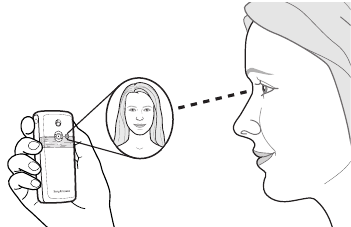
Camera 55
You can also take a self-portrait. Hold the phone as
shown in the illustration. You can see your reflection
in the mirror provided. Press the camera button on
the side of the phone to activate the camera. Press
the camera button again to take the picture.
To attach the mirror to your phone
1. Remove the back cover and rubber plug from
the phone.
2. Place the mirror in the opening and press down
to secure it.
Options
When the camera is activated, press More for the
following options.
My Pictures – View all your pictures.
Size – Choose between 288x352 or 120x160.
Night Mode – Use in poor lighting conditions.
Effects – Select different effects for your picture.
Default Name – Create a name for your picture.
Self Timer – The picture is taken approximately
10 seconds later. You will be prompted with audio
beeps when the phone is preparing to take the
picture. You must reset the timer after every picture.
Note: All phones that support pictures can receive
the picture size 120x160. Some phones that support
pictures cannot receive the picture size 288x352.
The best picture size to view on a PC is 288x352.
Saving and deleting pictures
When you have taken a picture, you can save it to
My Pictures.
If Memory Full appears, you cannot save any
more pictures until you have deleted an item from
the phone’s memory.
T610UG-R3A.book Page 55 Tuesday, May 27, 2003 5:16 PM
56 Setting up WAP and Email
Picture messaging
Before you send a picture message, you need to
enter your service center number and WAP settings
in your phone. Your network operator provides you
with the settings. See “Setting up WAP and Email”
on page 56. The phone that you are sending the
picture to needs to support data transmission and
pictures in order to receive and show the picture.
To take and send a picture
1. Scroll to Camera.
2. Take a picture by pressing Capture.
3. Press Send to select a sending option.
4. Highlight one of the following send options:
•As MMS
• As Email
• Via Bluetooth
• Via Infrared
5. Press Select.
Setting up WAP and Email
In order to use the Internet, browse via Internet
Services or send and receive picture and email
messages, the following are required:
1. A phone subscription that supports data transmission.
2. Settings entered in your phone.
• Your settings may already be entered when you
buy your phone.
• You can receive settings in a text message
from your network operator or service provider.
Settings are also available at
www.SonyEricsson.com/
• You can set up with the wizard in Connect, WAP
Options, WAP Profiles, New Profile. The wizard
is also started when you try to access the Internet
without having configured a profile.
3. You may also have to register as a WAP/email user
with your service provider or network operator.
Note: Some settings are not necessarily mandatory.
Please consult your network operator or service
provider for more information.
T610UG-R3A.book Page 56 Tuesday, May 27, 2003 5:16 PM

Setting up WAP and Email 57
Receive settings in a text message
Your GSM network operator or Internet
service provider may be able to send the
required data account, WAP and email
settings direct to your phone in a text message.
Set up with the wizard
If your phone is not set up for WAP, you can ask
your network operator or service provider to provide
you with WAP settings information. Then you can
simply use the wizard in your phone to help guide
you through the relevant settings.
Note: The wizard starts automatically if no WAP
settings exist in your phone.
To set up using the wizard
1. Scroll to Internet services, and select a homepage
(for example Sony Ericsson).
2. Create Now? appears. Press Yes.
3. Enter a name for the profile. Press Ok.
4. Select Connect Using. Press Edit.
5. Select New Account. Press Add.
6. Select an account type, GSM Data or GPRS Data.
7. Select New Account, and press Edit, enter the
following:
• A name for the data account.
• For GSM enter phone number and for GPRS enter
APN (Access point name address) – the address
of the external data network you want to connect
to, either an IP address or a text string.
• Use your user ID to log on to the external data
network.
• Use your password to log on to the external data
network.
• Save the new data account.
• Select the new data account to be used.
8. Enter IP address for the gateway.
9. Save the new profile.
Enter or edit settings manually
You can manually enter or edit settings information
from your network operator or service provider.
To create profile settings manually
1. Scroll to Connect, WAP Options, WAP Profiles.
2. Select New Profile and press Add to create a new
profile, or select an existing profile and press Edit to
edit an existing profile.
• See steps 3 - 7 in “To set up using the wizard” on
page 57.
T610UG-R3A.book Page 57 Tuesday, May 27, 2003 5:16 PM
58 Setting up WAP and Email
Note: If no settings exist, you must enter data
account (connection settings) as well as WAP profile
settings.
3. Enter or edit settings until all required information is
entered. Press Save.
To edit profile settings
1. Scroll to Connect, WAP Options, WAP Profiles.
2. Select an existing profile and press Edit to edit an
existing profile.
When editing a profile, you can do the following:
• Change the name of the profile.
• Select data account.
• Enter, Select, ChangeWAP gateway server
address.
• Add more profile settings, see below.
• Remove the profile.
If you select Advanced settings you can also do the
following:
• Enter the address of the WAP site you want to
have as your homepage.
• Select an alternative data account, if the first fails.
• Enter your user ID for the WAP gateway.
• Enter your password for the WAP gateway.
• See WAP security.
• View pictures while browsing.
Data account
You may want to create or edit an existing data
account.
To create a data account manually
1. Scroll to Connect, Data Comm., Data Accounts.
2. See steps 5 - 7 in “To set up using the wizard” on
page 57.
To edit a data account
1. Scroll to Connect, Data Comm., Data Accounts.
2. Select a data account.
3. Select Edit.
4. Select the setting you want to edit.
5. Repeat step 4 for other settings you want to edit.
More settings information
To use the WAP browser, via a WAP service
provider, you need settings for:
• a specific data account for WAP, and a WAP profile.
T610UG-R3A.book Page 58 Tuesday, May 27, 2003 5:16 PM
Setting up WAP and Email 59
To use email messaging, via an Internet service
provider, you need settings for:
• a specific data account for email, and an email
account.
To send a text message to an email address via your
network operator, you need to set:
• an email gateway phone number.
Descriptions
A data account includes connection settings for
access to an Internet server at your service provider.
A WAP profile includes user settings that allow
browsing and picture messaging.
An email account includes user settings that allow
email messaging direct from your phone, such as
those provided by your Internet service provider.
Alternatively, Email via WAP includes user settings
that also allow email messaging, such as those
provided by your Internet service provider. However,
this is set up on your service provider’s WAP site.
Note: Check with your WAP service provider if their
site supports email.
WAP profile
The WAP settings are stored in a WAP profile.
In most cases, you only need to use one profile to
access the Internet.
You set up and use additional WAP profiles, for
example, when accessing secure Internet sites, such
as a banking site or a corporate intranet. You then
simply switch between profiles when you need to
change the network connection. See “To set up using
the wizard” on page 57 for more information.
Data account
You can have several data accounts saved in your
phone with different settings for different purposes.
The main setting for a data account is the connection
method.
Data account settings can be created with the
wizard. See “Set up with the wizard” on page 57.
You can choose either GSM Data or GPRS Data
account types.
Note: Please contact your network operator for
charging details.
T610UG-R3A.book Page 59 Tuesday, May 27, 2003 5:16 PM
60 Setting up WAP and Email
GPRS (General Packet Radio Service) allows access
where you can always be online.
Note: You need a subscription that supports GPRS.
GPRS settings that are available:
• APN – the address of the external data network
you want to connect to, either an IP address or a
text string.
• Your user ID to log on to the external data network.
• Your password to log on to the external data
network.
• Password request – if this setting is on, you are
asked for a password each time you log on to
the external data network.
• Preferred service – if you want to be able to
accept incoming calls during a GPRS session,
select Automatic. If not, select GPRS Only.
• The IP address that the phone uses when
communicating with the network. If you do not
enter an address, the network provides you with
a temporary IP address.
• If the network does not provide the IP address to
the DNS server automatically, you may enter it here.
• Advanced settings – these are optional. Consult
your network operator.
GSM settings include some settings that are similar
to GPRS settings and some that are GSM specific as
follows:
• The phone number of your Internet service provider.
• Select the speed you want for the connection.
• Select analog connection.
Note: If you want to change access type, you have to
create a new data account and select the access type
you want to use.
Preferred service
You can set GPRS or GSM as the preferred service.
To select preferred mode
• Scroll to Connect, Data Comm., Preferred Service
and select GPRS and GSM or GSM Only.
WAP security
Your phone has support for WAP secure browsing.
When you turn on security, the connection between
your phone and the WAP gateway is secure.
Note: Security for a connection between a WAP
gateway and a WAP service provider is the
responsibility of the WAP service provider.
T610UG-R3A.book Page 60 Tuesday, May 27, 2003 5:16 PM
Setting up WAP and Email 61
To turn on a secure connection
1. Scroll to Connect, WAP Options, WAP Profiles.
2. Select the profile to be used. Press Edit.
3. Select Advanced, Security.
4. Select On or Off.
Security module (Locks)
The security module is located on the SIM card, if
your network operator or service provider supplies
such a service. It can contain both certificates and
your private keys. The security module is protected
by a special access PIN and your phone asks you for
it when establishing a secure connection.
To enter the access PIN (for the security
module) and the signature PIN
•Scroll to Connect, WAP Options, Security, Locks.
Digital signatures
You can sign a contract with your phone by entering
a digital signature PIN as if signing with a pen on
paper. Digital signature records can be traced back
to your private key through a certificate that is used
for signing a contract.
All transactions (signed contracts) made with
your phone when browsing are stored in your phone.
To check your contracts
•Scroll to Connect, WAP Options, Security, Contracts.
Trusted certificates and Client certificates
To establish a secure connection when using certain
WAP services, for example banking or WAP shopping,
you need certificates in your phone.
• The different types of certificates are as follows:
1. Server certificates are used to identify a WAP
gateway to the phone and to show that it is certified
by a trusted authority. The server certificate is
checked against trusted certificates that are stored in
the phone or in a security module. If the phone
cannot verify the identity of a server, you are given
the option to terminate or continue the connection.
2. Trusted certificates are used to verify the WAP
gateway that you are trying to connect to. Your
phone may already contain trusted certificates when
you buy it. If you have a security module, it may also
contain trusted certificates. You can also download
trusted certificates from www.SonyEricsson.com.
3. Client certificates are located in a security module
together with your private keys. Client certificates
can be used to present your identity to a bank or
other services. They can also be used for digital
signatures.
T610UG-R3A.book Page 61 Tuesday, May 27, 2003 5:16 PM
62 Setting up WAP and Email
To check the certificates in your phone
•Scroll to Connect, WAP Options, Security, Client
Certificates.
Email account settings
An email account specifies, for example, the server
that is used for your email messages.
There are three ways to create an email account:
• send a request in a text message
• create an email account manually
• use the Internet
To request settings in a text message
1. Scroll to Messages, Email, Options.
2. Select Auto Configure, Send.
To create an email account manually
1. Scroll to Messages, Email, Options.
2. Select Edit Account.
3. Select Add New?
4. Enter a name for the account, for example Home
or Office.
5. Select Connect Using.
6. Select the data account you want to use with this
e-mail account.
7. Enter the rest of the settings in the list, some of which
are optional. To enter the settings, scroll to the
setting, press Select and enter the information. Press
Ok to confirm. Repeat this for each required setting.
You use the same email settings in your phone as in
your PC email program. If you do not have an email
service, contact your operator to get all the necessary
settings.
•Protocol – select POP3 or IMAP4.
•Incoming Server – enter the name or IP address
of the service provider for incoming email messages.
For example, mail.server.com or 10.1.1.1.
•Incoming Port – if needed, change the number of the
port used by the protocol you are using.
•Mailbox – enter a user name for your email account.
•Password – enter a password for your email account.
Your service provider may alternatively request a
password on connection.
•Outgoing Server – enter the name or IP address of
the SMTP server to be able to send email messages.
•Outgoing Port – if needed, change the number of the
port used by the SMTP protocol.
•Email Address – enter your email address.
T610UG-R3A.book Page 62 Tuesday, May 27, 2003 5:16 PM
Using WAP 63
•Download – select whether to receive headers and
text or headers only.
•From Name – enter your name.
•Signature – select if you want to add your business
card to your email messages.
•Copy Outgoing – Select On, if you want email
messages sent from your phone also to be sent to
an email address of your choice. This way, your sent
mes ages are copied and can be saved for future
reference.
•Check Interval – Select how often you want the
phone to connect to your email server and check
for incoming email messages.
If you have both an office and a home email account,
you can set one of them as default:
•Select Set Account from the Messages, Email,
Options menu and select the account.
Using WAP
Your phone has a WAP (Wireless Application
Protocol) browser and email messaging which are
designed to bring a modified Internet to your mobile
phone. A wide range of services are available, for
example, news, entertainment, timetables, reservations,
banking, e-commerce, positioning and email.
Before you start
First make sure that you have:
• A phone subscription that supports data transmission.
• Correct settings in your phone for mobile Internet,
WAP and/or email messaging.
• Registered as a WAP/Email user with your network
operator or service provider.
Note: See “Email account settings” on page 62 or
“Email” on page 51 for more information about
e- mail set-up and messaging.
To select a WAP profile
1. Scroll to Connect, WAP Options, WAP Profiles.
2. Select the profile you want to use.
You then return to the WAP Options menu and the
WAP profile is selected.
T610UG-R3A.book Page 63 Tuesday, May 27, 2003 5:16 PM
64 Using WAP
Using the WAP browser
To start browsing
• Select either the top middle or top left icon on the
desktop. When the WAP page is loaded into the
phone, press More and select from the following:
• Open your home page at the top of the list, for
example, SonyEricsson.
• Go to one of your bookmarks. Select Bookmarks.
• Enter the address of a WAP site. Select Enter
Address, to enter a new WAP address or select
one of the 10 most recently entered addresses.
Tip: When you enter a WAP address, the normal
http:// prefix is not needed.
To exit WAP and disconnect
• Press More and scroll to Exit WAP.
Options when browsing
1. Select More.
2. Select one of the following:
• Go to the home page set for the current profile.
• Add the site you are currently browsing to your
list of bookmarks, or see the list of bookmarks for
the current profile.
• Enter the WAP address of a site you want to visit.
• Save a picture from the site.
• Send a text message with a link to the current
WAP page to another phone.
• Send a link to the current site to another phone via
infrared or Bluetooth.
• Refresh the contents of the WAP page.
• Disconnect and go to standby.
• Display current status information, for example,
profile, access type, connection time, data rate,
security, address.
• Set the current site as the home page of the WAP
profile you are using.
Note: If you select an email address when browsing
a WAP site, you can reply with a text message.
Using bookmarks
You use bookmarks in your mobile phone just as you
do with a PC Internet browser. You can have up to
25 bookmarks.
To work with bookmarks
1. Scroll to Internet Services.
2. Press More, Bookmarks.
3. Select the bookmark you want to work with.
T610UG-R3A.book Page 64 Tuesday, May 27, 2003 5:16 PM
Using WAP 65
4. Press More and select one of the following options:
•Go to – Go to the marked WAP address.
•Edit – Edit the name and/or the WAP address of
the bookmark.
• Delete – Delete the bookmark.
•Send As Text Msg – Send a link to the WAP
address in a text message.
•Send – Send a link to the current WAP address via
infrared.
•Set As Homepage – Set the WAP address as the
home page.
Downloading
You can download pictures, themes, games and ring
tones, for example, from WAP sites directly to your
phone.
To download from wap.sonyericsson.com
1. Scroll to SonyEricsson.
2. Select what you want to download and follow the
instructions that appear.
Note: Be sure to download themes specifically for
your Sony Ericsson mobile phone model. Themes
designed for use with other Sony Ericsson phone
models will not work properly.
Stored information
The following information can be saved in your phone:
• Cache – improves memory efficiency.
• Passwords – improves server access efficiency.
• Cookies – improves site access efficiency.
To clear cache
Scroll to Connect, WAP Options, Clear Cache.
To remember passwords
Scroll to Connect, WAP Options, Passwords,
Remember Pwds.
To clear passwords
Scroll to Connect, WAP Options, Passwords,
Clear Pwds.
To allow cookies
1. Scroll to Connect, WAP Options, Cookies.
2. Select Allow Cookies.
To clear cookies
1. Scroll to Connect, WAP Options, Cookies.
2. Select Clear Cookies.
It is advisable to clear any sensitive information about
previously visited WAP services. This is to avoid a
security risk if your phone is misplaced, lost or stolen.
T610UG-R3A.book Page 65 Tuesday, May 27, 2003 5:16 PM
66 Transferring and exchanging information
Transferring and exchanging
information
Bluetooth™ wireless technology
Your phone has built-in Bluetooth wireless technology
which makes it possible for you to connect your
phone wirelessly to other Bluetooth devices such
as a handsfree, PC or other phones. You can, for
example, have a conversation (via a cordless
Bluetooth handsfree) or browse the Internet
(wirelessly connected via your mobile phone).
You can automatically synchronize information in
your phone and your PC. You can also exchange,
for example, contacts, calendar items and pictures.
Note: We recommend that your phone and the
Bluetooth device you are communicating with are
within a range of 33 feet. The connection may be
improved if there are no solid objects in between
your phone and the other Bluetooth device.
Before you start
To communicate with another Bluetooth device,
you first need to add the device to the list of paired
devices. To synchronize with your PC, and to
browse the Internet, you also need to install software
on your PC from the Sony Ericsson web site,
www.SonyEricsson.com/support/.
You can exchange items or play games without
having to add the other device to the list of My devices.
To turn Bluetooth on
1. In standby, press More.
2. Select Turn On Bluetooth.
Note: To conserve battery power, turn off Bluetooth
when not in use.
To add a device to your phone
1. Scroll to Connect, Bluetooth, My Devices, New Device.
Press Add and your phone searches for all types of
available devices. Press More if you want to select
a specific type of device to search for.
2. The phone searches for Bluetooth devices. A list
of available devices appears in the display. Select
a device.
3. Enter a passkey (up to 16 digits) for the device,
both in the phone and, for example, in the PC. (If a
passkey does not come with the Bluetooth device
when you buy it, you need to create one yourself.)
T610UG-R3A.book Page 66 Tuesday, May 27, 2003 5:16 PM
Transferring and exchanging information 67
Note: To add a device or accept the addition of
a device to My devices means that the device has
access to functionality and content in the phone.
To organize your list of devices
Scroll to Connect, Bluetooth, My Devices. Then
select a device from the list and press More to view
a list of options.
Phone name
You can choose a name for your phone. This name
is shown in other devices when your phone is found,
and is also used for the infrared port.
• To enter a name, scroll to Connect, Bluetooth,
Options, Phone Name.
In order for your phone to be found by other
Bluetooth devices, you must make sure Bluetooth is
turned on and your phone is visible to other devices.
To hide or show your phone when using
Bluetooth
1. Scroll to Connect, Bluetooth, Options, Visibility.
2. Select Show Phone or Hide phone.
Handsfree
To add a Bluetooth handsfree to your phone
1. Scroll to Connect, Bluetooth, Handsfree,
My Handsfree, New Handsfree.
2. Select Add.
Transferring sound when using a handsfree
When you are using a Bluetooth handsfree with your
phone, you can choose where the sound should be
transferred during a call.
• Scroll to Ongoing Call, Transfer Sound or select
More in standby during the call.Then select either to
transfer sound to the phone or to other handsfree
devices that have been added to your phone.
• You can select where to direct the sound when
making a call.
• Scroll to Connect, Bluetooth, Handsfree, Ongoing
Call, then select In Handsfree, In Phone, Always Ask.
Sending and receiving
To send an item using Bluetooth wireless technology,
you need to make sure that the devices are within
33 feet.
T610UG-R3A.book Page 67 Tuesday, May 27, 2003 5:16 PM
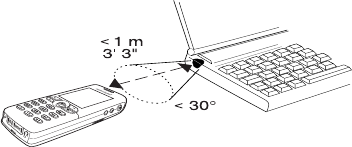
68 Transferring and exchanging information
To send an item
After you select Bluetooth as the transfer method, a
list of possible receivers is presented. First in the list
will be the last device you were in contact with and
devices that have been previously added to your
phone. The phone also searches for other devices
which are shown in the list
Tip: You can send certain items in your phone
(calendar overviews, appointments and tasks,
contacts, text messages) to specific Bluetooth
printers.
Note: In countries where the use of Bluetooth
wireless technology is not allowed, you must
ensure that the Bluetooth function is set to Off.
Infrared port
You can use the built-in infrared port to establish
contact between your phone and a PC or another
device equipped with an infrared port.
Activate the infrared port
Before you can connect to another infrared device
you have to activate the infrared port in your phone.
• To activate the infrared port, scroll to Connect,
Infrared Port. From standby, you can also select
More, Turn On IR.
Note: To conserve battery power, turn off Infrared
when not in use.
Note: Infrared will remain on for 10 minutes after
the last item is sent or received.
To connect two devices
1. Place your phone as in the picture. The infrared port
on the phone must face the infrared port on the other
device.
Note: If you are connecting to a PC, make sure your
PC has activated infrared communication (Start,
T610UG-R3A.book Page 68 Tuesday, May 27, 2003 5:16 PM
Transferring and exchanging information 69
Settings, Control Panel, Infrared, Options tab,
Enable infrared communication).
2. Your phone now establishes contact with the other
device.
Synchronization
You can synchronize the Calendar and Phonebook in
your phone with similar programs in, for example, a
PC, PDA or mobile phone and with similar programs
on the Internet.
• To select which order first name and last name
appear in the phone when you synchronize contacts,
scroll to Phonebook, Options, Synchronize View.
Synchronization with nearby devices
After installing the synchronization program
from the Sony Ericsson WAP site,
www.SonyEricsson.com/support/, you can
synchronize your phone with your PC.
A status bar shows the progress of the
synchronization. If you use a cable, the synchronization
starts as soon as you connect the cable. For more
information, please refer to the synchronization
software online help.
Internet synchronization
You can synchronize your mobile phone contacts,
appointments and tasks with similar programs on the
Internet, using WAP. Contact your network operator
for more information about these programs on the
Internet and to receive user ID, password and
addresses for the different programs. You must
also have a WAP profile set in your mobile phone.
Fax and data calls
Send fax and data calls
To send fax messages and make data calls, you need to
connect your phone to a computer, and then start the
appropriate software program.
Receive fax and data calls
The procedure of receiving fax messages and data
calls depends on your network and subscription. If you
have separate numbers for voice, fax and data calls,
your phone recognizes the type of call.
To receive a fax or data call (separate numbers)
1. Connect your phone to a computer.
2. Answer the call from within the software program (if it
does not answer automatically).
You cannot answer a fax or data call by pressing Yes
on the phone.
T610UG-R3A.book Page 69 Tuesday, May 27, 2003 5:16 PM
70 More features
One number
If you have a SIM card that does not support
separate fax and data numbers, the phone does not
recognize the type of incoming call.
If you want to receive a fax or data call, you have
to set the phone to one of these options. Once you
have set your phone for a specific incoming call, it
stays like this until you change it.
To select the call type you want your next
incoming call to be, scroll to Calls, Next Call,
Next Incoming.
More features
Alarm clock
The alarm can be set to ring at a specific time within
24 hours, or recurrently at a specific time on several
days. You can have both these alarms set at the same
time. Even if you have set your phone to silent, the
alarm and timer signals ring. The alarm clock also
rings if the phone is turned off.
To set an alarm
1. Scroll to Organizer, Alarms, Alarm.
2. Enter the time, Save.
• To change the alarm time, scroll to Organizer,
Alarms, Alarm, New Time.
• Press any key to turn the alarm signal off when it
rings. If you do not want the alarm to be repeated,
press Yes.
• To cancel the alarm, scroll to Organizer, Alarms,
Alarm, Cancel.
• To set a recurrent alarm, scroll to Organizer, Alarms,
Recurrent Alarm. Then enter the time and select the
days that you want the alarm to recur by scrolling
and pressing Check. Press Save to exit the menu.
• To select an alarm signal, scroll to Settings, Sounds
and Alerts, Alarm Signal.
T610UG-R3A.book Page 70 Tuesday, May 27, 2003 5:16 PM

More features 71
Stopwatch
Scroll to Organizer, Stopwatch.
• Press Start to start the stopwatch.
• Press New lap to start a new lap time.
• Press Stop to finish.
• Press Restart to restart the stopwatch.
• Press Reset to reset the stopwatch.
Note: The stopwatch is turned off when you answer
an incoming call or when you exit the stopwatch
menu.
Timer
The phone has a 24-hour timer.
• To set the timer, scroll to Organizer, Timer. When
the signal rings, press any key to turn it off.
Calculator
The phone has a calculator, which can add, subtract,
multiply, divide and calculate percentages.
• Enter a digit and scroll to a symbol (+, -, x, /, %, .).
• Press to delete a digit or symbol.
• Press to start a new calculation.
Code memo
Instead of having to remember all the different
security codes for credit cards, you can, for example,
save them in the code memo in your phone. Then all
you need to remember is the password to open the
code memo. You can save a maximum of ten codes
in the code memo.
Checkword and security
To confirm that you have entered the correct
password for the code memo and to prevent
unauthorized access to your codes, you must enter a
checkword. When you enter your password to open
the code memo, the checkword is shown for a short
time. If the password is correct, the correct codes
are shown. If you enter the incorrect password, the
checkword and the codes that are shown are also
incorrect.
Factors strengthening the security of the Code
memo function are:
• You get no feedback about whether the password
is correct, except for the checkword, and only you
know the checkword.
• All codes are encrypted in the mobile phone.
• When you access your codes, they are shown for
a limited time only.
T610UG-R3A.book Page 71 Tuesday, May 27, 2003 5:16 PM
72 More features
To open code memo for the first time
1. Scroll to Organizer, Code Memo.
A message with instructions appears.
2. Press Ok.
3. Enter a four-digit password to open Code Memo, Ok.
4. Re-enter the new password to confirm.
5. Enter a checkword (maximum 15 characters), Ok.
The checkword can consist of both letters and
numbers. To enter a number, press and hold the key.
To add a new code
1. Scroll to Organizer, Code Memo.
2. Enter your password.
3. Select New Code, Add.
4. Enter a name associated with the code, for example,
the name of the credit card company, Ok.
5. Enter the code, Ok.
To open code memo
1. Scroll to Organizer, Code Memo.
2. Enter your password, Ok.
Your entered checkword appears. When the
decryption process has finished, your codes are shown.
To change the password
1. Open code memo as described above.
2. Press More, Change Password.
3. Enter your new password, Ok.
4. Re-enter the new password, Ok.
5. Enter a checkword, Ok.
Forgot your password?
If you forget your password, just enter any password
to access the Code memo function. The checkword
and codes that are then shown are incorrect. You
must now reset the Code memo.
To reset code memo
1. Press More, Reset.
2. Reset Code Memo? appears. Press Yes.
The Code memo is reset and all entries are cleared.
The next time you enter the Code memo, you must
start at “To open code memo for the first time” on
page 72.
Calendar
You can use the calendar to keep track of important
meetings that you need to attend, phone calls that
you need to make or tasks that you need to do. The
T610UG-R3A.book Page 72 Tuesday, May 27, 2003 5:16 PM

More features 73
calendar can be synchronized with a PC calendar or,
using WAP, with a calendar on the Web. For more
information see “Synchronization” on page 69.
Appointments and tasks
You can save up to 300 appointments and 80 tasks
in your calendar, depending on the size of each item.
You can choose to add a new appointment or task,
or to use an old appointment or task as a template
by copying and editing it.
Tip: When you are in the list of appointments and
tasks for a certain day, you can press More to edit,
delete, reschedule, send or copy. You can also call
a number included in a phone call task.
To add a new appointment
1. Scroll to Organizer, Calendar, Add Appointment.
2. Enter the appropriate information, for example,
subject, location, icon and times. Confirm each entry
with Ok, Select, or Save.
3. If you want to set a reminder for your appointment,
select a reminder.
To add a new task
1. Scroll to Organizer, Calendar, Tas k s, New Task, Add.
2. Select a category.
• If the category is a phone call, enter the phone
number, Ok.
3. Enter a subject, Ok.
4. If you want to set a reminder for your appointment,
press Yes. Save the date and time.
Viewing your calendar
To view your calendar content, scroll to Organizer,
Calendar, and then select one of the following:
•View Today – All appointments for today as well
as unfinished tasks are shown.
•View Week – Move within and among the days
by moving the joystick. Press Select to view a
certain day.
•View Month – Move within and among the days
or weeks by moving the joystick. Press Select
to view a certain day. Days on which you have
appointments are marked in bold.
Tip: In the monthly and weekly views, you can go to
next week by pressing 3, to next month by pressing 6
and to next year by pressing 9. You can go back a
week, a month or a year by pressing 1, 4, and 7
respectively. To reach the current day, press .
T610UG-R3A.book Page 73 Tuesday, May 27, 2003 5:16 PM
74 More features
Calendar settings
•Select Options from the Organizer, Calendar menu
and then select one of the options:
•View.
Starting Day – Select a start day for the week.
Week Display – Select 5-day week or 7-day week.
•Profile Switch – If you want the phone to remind
you to switch profile when a meeting is about to
start, select Manual. If you want the profile to be
switched automatically, select Auto, then select a
profile.
•Reminders – Select Always if you want the
reminder to sound even though the phone is
turned off.
Check the status
You can check how much space is left for new
appointments and tasks.
• To check the status, scroll to Organizer, Calendar,
Advanced, Memory Status.
Tip: To delete all appointments and tasks in your
calendar, select Delete All in the Advanced menu.
Exchanging calendar entries
You can send and receive appointments and tasks
using Bluetooth wireless technology, the infrared
port or picture message.
To send an appointment or a task
1. In the list of appointments and tasks for a certain day,
scroll to the item you want to send and press More.
2. Select Send.
3. Select a transfer method.
To receive an appointment or a task
1. From standby, press More and scroll to Turn On
Bluetooth or Turn On IR.
Both the infrared port and the Bluetooth function are
activated for ten minutes.
2. Add Appointm.? or Add Task? appears. Press Yes
to save the appointment or task in your calendar.
If your phone’s memory is full, you must remove
some items before you can save any new ones.
Find an appointment or task
You can search for appointments and tasks that
contain a specific text.
T610UG-R3A.book Page 74 Tuesday, May 27, 2003 5:16 PM
More features 75
To search for appointments or tasks
1. Scroll to Organizer, Calendar, Advanced, Find.
2. Check or uncheck if you want to search for
appointments or tasks (if you have added any).
Press Save.
3. Enter the text you want to search for, Ok.
Appointments or tasks that match your search are
shown. Select to view the item or edit, delete,
reschedule, send, or copy the item by pressing More.
Sound recorder
With the Sound recorder function, you can record
either your own memos or calls. All participants in
the call are automatically recorded. The recording is
stopped if any party ends the call.
The recordings are saved in your mobile phone and
can be accessed even if you change your SIM card.
Note: In some countries or states it is required by
law that you inform the other person before
recording the call.
To start a sound recording
•Scroll to Pictures & Sounds, Record Sound.
• Wait until you hear a tone. When the recording
starts, the display shows Recording together with the
time of the current recording.
To end the recording
• Press Cancel.
Tip: You can start recording or listening to
recordings with a voice command. See “Voice
control” on page 32.
The recording stops automatically if you receive an
incoming call or when the call ends. You hear a tone
a few seconds before the memory is full.
Listening to recordings
You can listen to your recordings at any time, even
during a call, and both people will hear them.
To listen to your recordings
1. Scroll to Pictures & Sounds, My Sounds.
2. Select the recording you wish to hear. Press Play.
To send a recording
1. Scroll to Pictures & Sounds, My Sounds.
2. Scroll to the recording you wish to send.
3. Press More and select Send.
T610UG-R3A.book Page 75 Tuesday, May 27, 2003 5:16 PM

76 More features
To delete or rename a sound recording
1. Scroll to Pictures & Sounds, My Sounds.
2. Scroll to the recording you wish to delete or rename.
3. Press More when the recording is highlighted.
4. Select Delete or Rename.
Settings
To see the information on your recordings
1. Scroll to Pictures & Sounds, My sounds.
2. Scroll to a recording. Press More.
3. Select Sound Info.
4. Both the date/time and length of the message are
shown.
Entertainment
Your phone has several entertaining applications and
games. You can play some of the games with another
person, both using your phone, or you can play on
two phones, using Bluetooth wireless technology
or infrared. You can also download games and
applications directly to your phone. Help texts are
available in some games and applications.
To start an application
1. Scroll to Games, Other Games.
2. Select an application, Start.
To download an application
1. Scroll to Games, Games & More.
2. Scroll to a direct link, Start.
Note: Make sure the file sizes do not exceed the free
memory in your phone. See “Checking the memory”
on page 32.
To start and end a game
1. Scroll to Games, Other Games.
2. Select a game, press Start.
3. Press More to read help texts.
4. Press to end the game.
Tip: If you press More, you will get more
information about your game.
To download a game
1. Scroll to Games, Other Games.
2. Select New Game, Go to Page.
T610UG-R3A.book Page 76 Tuesday, May 27, 2003 5:16 PM

More features 77
How to control the games:
Use the joystick to move up, down, left or right and
to select an item, or use the keys as follows:
Notes
If you need to remember something, you can make a
note of it in your phone. You can add, edit, delete or
send a note. You can save 10 notes.
To add a note
1. Scroll to Organizer, Notes, New Note, Add.
2. Enter the note, Ok.
To view the notes
1. Scroll to Organizer, Notes.
2. A list which shows the beginning of each note
appears. Select the note that you want to view.
Post note
You can display a note in standby mode.
To display a note in standby
1. Press More and scroll to Post Note.
2. Select the note you want to display in standby or
select New Note to write a new note.
• If the note is long and you cannot see all of it, press
More, Show Note.
• To turn off the note in standby, press More, Hide note.
Exchanging notes
You can send and receive notes using Bluetooth
wireless technology, the infrared port or picture
messaging.
To send a note
1. Scroll to a note and press More to display the list of
options.
2. Select Send.
3. Select a transfer method.
To receive a note
1. From standby, press More and scroll to Turn On
Bluetooth or Turn On IR.
Both the infrared port and the Bluetooth function are
activated for ten minutes.
2. Add Note? appears. Press Save to save the note
among your other notes.
left up up right up
left select/fire right
left down down right down
T610UG-R3A.book Page 77 Tuesday, May 27, 2003 5:16 PM

78 Security
Security
SIM card lock
The SIM card lock protects your subscription, but
not your phone itself, from unauthorized use. If you
change SIM cards, the phone still works with the
new SIM card.
Most SIM cards are locked at the time of purchase.
If the SIM card lock is on, you have to enter a “PIN”
(Personal Identity Number) every time you turn on
your phone.
If you enter your PIN incorrectly three times in a
row, the SIM card is blocked. This is indicated by
the message PIN Blocked. To unblock it you need to
enter your “PUK” (Personal Unblocking Key). Your
PIN and PUK are supplied by your operator.
To unblock your SIM card
1. PIN Blocked appears in the display.
2. Enter your PUK and press Ok.
3. Enter a new four- to eight-digit PIN and press Ok.
4. Re-enter the new PIN to confirm and press Ok.
• To edit your PIN, scroll to Settings, Locks, SIM
Lock, Change PIN.
Note: If the message “Codes Do Not Match”
appears, you entered the new PIN incorrectly. If the
message “Wrong PIN” appears, followed by “Old
PIN:”, you entered your old PIN incorrectly.
• To edit your PIN2, scroll to Settings, Locks, SIM
Lock, Change PIN2.
To turn the SIM card lock on or off
1. Scroll to Settings, Locks, SIM Lock,
Protection.
2. Select On or Off.
3. Enter your PIN and press Ok.
Phonelock
The phonelock protects the phone against
unauthorized use if it is stolen and the SIM card is
exchanged. It is not on when you buy the phone.
You can change the phonelock code (0000) to any
four- to eight-digit personal code. The phonelock
can be set to on, automatic or off.
Phone lock on
If the phone lock is on, the message Phone Locked
appears each time you turn on the phone. You have
to enter your code followed by Yes to use your
phone.
T610UG-R3A.book Page 78 Tuesday, May 27, 2003 5:16 PM

Troubleshooting 79
Automatic
If the phonelock is set to automatic, you do not need
to enter your phonelock code until a different SIM
card is inserted in the phone.
• To edit your phonelock code, scroll to Settings,
Locks, Phonelock, Change Code.
Note: It is important that you remember your new
code. If you should forget it, contact your service
provider.
To set the phone lock
1. Scroll to Settings, Locks, Phonelock, Protection.
2. Select an alternative.
3. Enter the phonelock code and press Ok.
Troubleshooting
This chapter lists some problems that you might
encounter while using your phone. Some problems
require that you call your service provider, but you
can easily correct most of the problems yourself.
The phone cannot be switched on
Hand-held phone
Recharge or replace the battery. See “SIM card and
battery information” on page 5.
No indication of charging
When you start charging a battery that is empty or a
battery that has not been used for a long time, it may
take up to 30 minutes before the battery icon appears
in the display.
Menu language
If the display shows a language that you do not
understand, you can always choose Automatic
(determined by your SIM card) by pressing 8888
in standby. You can always choose English by
pressing 0000 in standby.
T610UG-R3A.book Page 79 Tuesday, May 27, 2003 5:16 PM

80 Troubleshooting
Grey menu options
Grey text indicates a function that is
temporarily unavailable, for example due to
your subscription or due to a certain setting
which has not been turned on.
Since you cannot send themes, pictures and
sounds that are copyright-protected, the Send menu
is sometimes unavailable.
Error messages
Insert SIM
There is no SIM card in the phone or you may have
inserted it incorrectly. Insert a SIM card. See “SIM
card and battery information” on page 5.
Insert Correct SIM card
The phone is set to work only with certain SIM
cards. Insert the correct SIM card.
Emergency Calls Only
You are within range of a network, but you are not
allowed to use it. However, in an emergency, some
operators allow you to call the international
emergency number 911. See “Making emergency
calls” on page 26.
No Network
There is no network within range or the received
signal is too weak. You have to move to get a signal
that is strong enough.
Wrong PIN/Wrong PIN2
You have entered your PIN or PIN2 incorrectly.
Enter the correct PIN or PIN2, and press Yes. See
“SIM card lock” on page 78.
Codes Do Not Match
When you want to change a security code (for
example, your PIN) you have to confirm the new
code by entering it again. The two codes that you
have entered do not match. See “SIM card lock” on
page 78.
PIN Blocked/PIN2 Blocked
You have entered your PIN or PIN2 incorrectly three
times in a row. To unblock your phone, see “SIM
card lock” on page 78.
T610UG-R3A.book Page 80 Tuesday, May 27, 2003 5:16 PM

Additional information 81
PUK Blocked – Contact Operator
You entered your personal unblocking key code
(PUK) incorrectly 10 times in a row. Contact your
network operator or service provider.
Phone Locked
The phone is locked. To unlock the phone, see
“Phonelock” on page 78.
Phonelock Code:
Your phone comes with the phone lock code, 0000.
You can change it to any four- to eight-digit code.
See “Phonelock” on page 78.
Number Not Permitted
The Fixed dialing function is on and the number you
have dialed is not on your fixed numbers list. See
“Fixed Dialing” on page 42.
Additional information
Guidelines for Safe and Efficient Use
Please read this information before using
your mobile phone.
RECOMMENDATIONS
• Always treat your product with care and keep it in a
clean and dust-free place.
• Do not expose your product to liquid or moisture or
humidity.
• Do not expose your product to extreme
high or low temperatures.
• Do not expose your product to open
flames or lit tobacco products.
• Do not drop, throw or try to bend your
product.
• Do not paint your product.
T610UG-R3A.book Page 81 Tuesday, May 27, 2003 5:16 PM

82 Additional information
• Do not use your product near medical equipment
without requesting permission.
• Do not use your product when in, or around aircraft,
or areas posted “turn off two-way radio”.
• Do not use your product in an area where
a potentially explosive atmosphere exists.
• Do not place your product or install
wireless equipment in the area above
your car’s air bag.
• Do not attempt to disassemble your
product. Only Sony Ericsson authorised
personnel should perform service.
• Do not direct the infrared ray at anyone's
eye and make sure that it does not disturb any other
infrared units.
ANTENNA
Only use an antenna that has been specifically
designed by Sony Ericsson for your mobile phone. Use
of unauthorised or modified antennas could damage
your mobile phone and may violate regulations,
causing loss of performance and SAR levels above
the recommended limits (see below).
EFFICIENT USE
Hold your mobile phone as you would any other
phone. Do not cover the top of the phone when in use,
as this affects call quality and may cause the phone to
operate at a higher power level than needed, thus
shortening talk and standby times.
RADIO FREQUENCY (RF) EXPOSURE
AND SAR
Your mobile phone is a low-power radio transmitter
and receiver. When it is turned on, it emits low levels
of radio frequency energy (also known as radio waves
or radio frequency fields).
Governments around the world have adopted
comprehensive international safety guidelines,
developed by scientific organizations, e.g. ICNIRP
(International Commission on Non-Ionizing Radiation
Protection), through periodic and thorough evaluation
of scientific studies. These guidelines establish
permitted levels of radio wave exposure for the general
population. All Sony Ericsson mobile phone models
are designed to operate within these stringent levels.
The levels include a safety margin designed to assure
the safety of all persons, regardless of age and health,
and to account for any variations in measurements.
Specific Absorption Rate (SAR) is the unit of
measurement for the amount of radio frequency
energy absorbed by the body when using a mobile
phone. The SAR value is determined at the highest
T610UG-R3A.book Page 82 Tuesday, May 27, 2003 5:16 PM
Additional information 83
the safety of all persons, regardless of age and health,
and to account for any variations in measurements.
Accessories can significantly affect a mobile
phone's compliance with the radio frequency exposure
guidelines. To avoid causing loss of performance or
radio frequency exposure levels above the permissible
limits, it is recommended that you only use Sony
Ericsson or Ericsson original accessories intended for
use with your mobile phone. If you wear the mobile
phone on your body while it is transmitting, and you do
not use a Sony Ericsson or Ericsson original body-
worn accessory, please ensure that the mobile phone
is positioned a minimum of 1.5 cm (0.6 in.) from your
body and that you are not using an accessory that
contains any metal.
Specific Absorption Rate (SAR) is the unit of
measurement for the amount of radio frequency
energy absorbed by the body when using a mobile
phone. The SAR value is determined at the highest
certified power level in laboratory conditions, but the
actual SAR level of the mobile phone while operating
can be well below this value.
This is because the mobile phone is designed to
use the minimum power required to reach the network.
Therefore, the closer you are to a base station, the
more likely it is that the actual SAR level will decrease.
Variations in SAR below the radio frequency
exposure guidelines do not mean that there are
variations in safety. While there may be differences in
SAR levels among various mobile phones, all Sony
Ericsson mobile phone models are designed to meet
radio frequency exposure guidelines.
A separate leaflet with SAR information for this
mobile phone model is included with the material that
comes with this mobile phone. This information can
also be found, together with more information on radio
frequency exposure and SAR, on
www.SonyEricsson.com/.
DRIVING
Please check if local laws and regulations restrict the
use of mobile phones while driving or require drivers to
use handsfree solutions. We recommend that you use
only Ericsson or Sony Ericsson handsfree solutions
intended for use with your product. Please note that
because of possible interference to electronic
equipment, some vehicle manufacturers forbid the use
of mobile phones in their vehicles unless a handsfree
kit with an external antenna supports the installation.
Always give full attention to driving and pull off the road
and park before making or answering a call if driving
conditions so require.
PERSONAL MEDICAL DEVICES
Mobile phones may affect the operation of cardiac
pacemakers and other implanted equipment. Please
avoid placing the mobile phone over the pacemaker,

84 Additional information
e.g. in your breast pocket. When using the mobile
phone, place it at the ear opposite the pacemaker. If a
minimum distance of 15 cm (6 inches) is kept between
the mobile phone and the pacemaker, the risk of
interference is limited. If you have any reason to
suspect that interference is taking place, immediately
turn off your mobile phone. Contact your cardiologist
for more information.
For other medical devices, please consult the
manufacturer of the device.
CHILDREN
DO NOT ALLOW CHILDREN TO PLAY
WITH YOUR MOBILE PHONE OR ITS
ACCESSORIES. THEY COULD HURT
THEMSELVES OR OTHERS, OR
COULD ACCIDENTALLY DAMAGE THE MOBILE
PHONE OR ACCESSORY. YOUR MOBILE PHONE
OR ITS ACCESSORY MAY CONTAIN SMALL PARTS
THAT COULD BE DETACHED AND CREATE A
CHOKING HAZARD.
DISPOSING OF THE PRODUCT
Your mobile phone should not be placed
in municipal waste. Please check local
regulations for disposal of electronic
products.
POWER SUPPLY
Connect the AC power adapter only to designated
power sources as marked on the product. Make sure
the cord is positioned so that it will not be subjected to
damage or stress. To reduce risk of electric shock,
unplug the unit from any power source before
attempting to clean it. The AC power adapter must not
be used outdoors or in damp areas. Never alter the
cord or plug. If the plug will not fit into the outlet, have a
proper outlet installed by a qualified electrician.
EMERGENCY CALLS
Mobile phones operate using radio signals, which
cannot guarantee connection under all conditions.
Therefore you should never rely solely upon any
mobile phone for essential communications (for
example, medical emergencies).
Emergency calls may not be possible on all cellular
networks or when certain network services and/or
mobile phone features are in use. Check with your
local service provider.
Emergency Response Center Location
Technology
Using wireless technology to help find you in case of
an emergency is a goal shared by the entire wireless
industry, local phone companies and the emergency
response centers. Your phone may support an
emergency positioning system being implemented by

Additional information 85
some service providers. But the complexity of mobile
communication technology, combined with related
implementation technologies, means that your wireless
carrier, the local phone companies, and emergency
response centers all have a role to play in
implementing this capability.
So even if your phone supports this technology and
even if the locating features works in one area there is
no guarantee that it will work in all areas for all calls to
emergency response centers. Always review with an
emergency response center all location data you have,
including intersecting streets, as well as any
landmarks, to assist in locating you.
Sony Ericsson is committed to continuing to work with
the entire communications industry to improve location
features for emergency response.
Sony Ericsson is not liable for any service(s) including
operation, coverage, or range of the network services
provided by network carriers independent of Sony
Ericsson.
BATTERY USE AND CARE
We recommend that you fully charge the battery
before you use your mobile phone for the first time.
The battery can only be charged in temperatures
between +5°C (+41°F) and +45°C (+113°F).
A new battery or one that has not been used for a
long time could have reduced capacity the first few
times it is used.
The talk and standby times depend on the actual
transmission conditions when using the mobile phone.
If the mobile phone is used near a base station, less
power is required and talk and standby times are
prolonged.
•Warning! May explode if disposed of in fire.
• Use only Ericsson or Sony Ericsson branded original
batteries and chargers intended for use with your
mobile phone. Other chargers may not charge
sufficiently or may produce excessive heat. Using
other batteries and chargers could be dangerous.
• Do not expose the battery to liquid.
• Do not let the metal contacts on the battery touch
another metal object. This could short-circuit and
damage the battery.
• Do not disassemble or modify the battery.
• Do not expose the battery to extreme
temperatures, never above +60°C
(+140°F). For maximum battery capacity,
use the battery in room temperature.
• Turn off your mobile phone before removing the
battery.

86 Additional information
• Keep out of children’s reach.
• Use the battery for the intended purpose
only.
• Do not allow the battery to be put into the mouth.
Battery electrolytes may be toxic if swallowed.
DISPOSING OF THE BATTERY
Please check local regulations for
disposal of batteries or call your local
Sony Ericsson Customer Care Center for
information.
The battery should never be placed in
municipal waste. Use a battery disposal facility if
available.
Limited Warranty
Sony Ericsson Mobile Communications AB, S-221 88
Lund, Sweden, (Sony Ericsson), provides this Limited
Warranty for your mobile phone and original accessory
delivered with your mobile phone (hereinafter referred
to as “Product”).
Should your Product need warranty service, please
return it to the dealer from whom it was purchased, or
contact your local Sony Ericsson Customer Care
Center (national rates may apply) or visit
www.SonyEricsson.com to get further information.
OUR WARRANTY
Subject to the conditions of this Limited Warranty,
Sony Ericsson warrants this Product to be free from
defects in design, material and workmanship at the
time of its original purchase by a consumer, and for a
subsequent period of one (1) year.
WHAT WE WILL DO
If, during the warranty period, this Product fails to
operate under normal use and service, due to defects
in design, materials or workmanship, Sony Ericsson
authorised distributors or service partners, in the
country/region* where you purchased the Product, will,
at their option, either repair or replace the Product in
accordance with the terms and conditions stipulated
herein.
Sony Ericsson and its service partners reserve the
right to charge a handling fee if a returned Product is
found not to be under warranty according to the
conditions below.
Please note that your personal settings/downloads
might be lost when the Product is repaired or replaced.
CONDITIONS
1. The warranty is valid only if the original proof of
purchase issued to the original purchaser by an, for
this Product, Sony Ericsson authorised dealer,
specifying the date of purchase and serial number**, is
presented with the Product to be repaired or replaced.
Additional information 87
Sony Ericsson reserves the right to refuse warranty
service if this information has been removed or
changed after the original purchase of the Product
from the dealer.
2. If Sony Ericsson repairs or replaces the Product, the
repaired or replaced Product shall be warranted for the
remaining time of the original warranty period or for
ninety (90) days from the date of repair, whichever is
longer. Repair or replacement may involve the use of
functionally equivalent reconditioned units. Replaced
parts or components will become the property of Sony
Ericsson.
3. This warranty does not cover any failure of the Product
due to normal wear and tear, or due to misuse,
including but not limited to use in other than the normal
and customary manner, in accordance with the Sony
Ericsson instructions for use and maintenance of the
Product. Nor does this warranty cover any failure of
the Product due to accident, software or hardware
modification or adjustment, acts of God or damage
resulting from liquid.
4. Since the cellular system on which the Product is to
operate is provided by a carrier independent from
Sony Ericsson, Sony Ericsson will not be responsible
for the operation, availability, coverage, services or
range of that system.
5. This warranty does not cover Product failures caused
by installations, modifications, or repair or opening of
the Product performed by a non-Sony Ericsson
authorised person.
6. The warranty does not cover Product failures which
have been caused by use of accessories or other
peripheral devices which are not Ericsson or Sony
Ericsson branded original accessories intended for use
with the Product.
7. Tampering with any of the seals on the Product will
void the warranty.
8. THERE ARE NO EXPRESS WARRANTIES,
WHETHER WRITTEN OR ORAL, OTHER THAN THIS
PRINTED LIMITED WARRANTY. ALL IMPLIED
WARRANTIES, INCLUDING WITHOUT LIMITATION
THE IMPLIED WARRANTIES OF
MERCHANTABILITY OR FITNESS FOR A
PARTICULAR PURPOSE, ARE LIMITED TO THE
DURATION OF THIS LIMITED WARRANTY. IN NO
EVENT SHALL SONY ERICSSON OR ITS
LICENSORS BE LIABLE FOR INCIDENTAL OR
CONSEQUENTIAL DAMAGES OF ANY NATURE
WHATSOEVER, INCLUDING BUT NOT LIMITED TO
LOST PROFITS OR COMMERCIAL LOSS, TO THE
FULL EXTENT THOSE DAMAGES CAN BE
DISCLAIMED BY LAW.

88 Additional information
Some countries/states do not allow the exclusion or
limitation of incidental or consequential damages, or
limitation of the duration of implied warranties, so the
preceding limitations or exclusions may not apply to
you.
The warranty provided does not affect the consumer's
statutory rights under applicable legislation in force,
nor the consumer's rights against the dealer arising
from their sales/ purchase contract.
* EUROPEAN UNION (EU)
If you have purchased your Product in an EU country
you can have your Product serviced, under the
conditions set out above, within the warranty period in
any EU country where an identical Product is sold by
an authorised Sony Ericsson distributor. To find out if
your Product is sold in the EU country you are in,
please call the local Sony Ericsson Customer Care
Center. Please observe that certain services may not
be possible elsewhere than in the country of original
purchase, for example due to the fact that your
Product may have an interior or exterior which is
different from equivalent models sold in other EU
countries. It may not be possible to repair SIM-locked
Products.
** In some countries/regions additional information is
requested. If so, this is clearly shown on the valid proof
of purchase.
FCC Statement
This device complies with Part 15 of the
FCC rules. Operation is subject to the
following two conditions: (1) This device
may not cause harmful interference, and (2) This
device must accept any interference received,
including interference that may cause undesired
operation.
Before a phone model is available for sale to the
public, it must be tested and certified to the FCC that it
does not exceed the limit established by the
government-adopted requirement for safe exposure.
The tests are performed in positions and locations
(that is, at the ear and worn on the body) as required
by the FCC for each model. For body worn operation,
this phone has been tested and meets FCC RF
exposure guidelines when the handset is positioned a
minimum of 15 mm from the body without metal parts
between the phone and the body or when used with
intended Sony Ericsson original body worn accessory.
Use of other accessories may not ensure complaince
with FCC RF exposure guidelines.
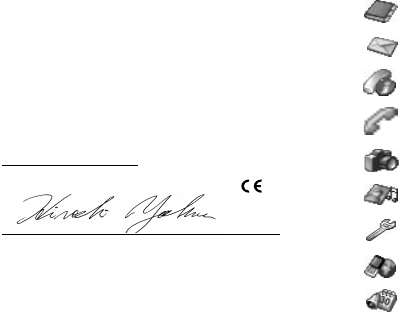
Icons 89
Declaration of Conformity
We, Sony Ericsson Mobile Communications AB of
Nya Vattentornet
S-221 88 Lund, Sweden.
declare under our sole responsibility that our product
Sony Ericsson type AAB-1031011-BV
and in combination with our accessories, to which this
declaration relates is in conformity with the appropriate
standards 3GPP TS 51.010-1, EN 301489-7,
EN 300328, EN 301489-17 and EN 60950, following the
provisions of, Radio Equipment and Telecommunication
Terminal Equipment directive 99/5/EC with requirements
covering EMC directive 89/336/EEC, and Low Voltage
directive 73/23/EEC.
We fulfil the requirements of the R&TTE Directive
(99/5/EC).
Icons
The table below shows icons which may appear in
standby or in the menus.
Lund, February 2003
Place & date of issue 0682
Hiroshi Yoshioka, Head of Product Business Unit GSM/UMTS
Icon Description
Desktop icons
Your personal phone book.
Handling of text, pictures, email and voice
messages.
Handling of call time, call cost information
and ongoing calls.
Handling of ongoing calls. Only available
during calls.
Camera function.
Handling of pictures, sounds and themes.
Personal settings including profiles, display,
language, time and locks.
Gives you access to Internet services.
Calendar, alarm clock and other extras.
T610UG-R3A.book Page 89 Tuesday, May 27, 2003 5:16 PM
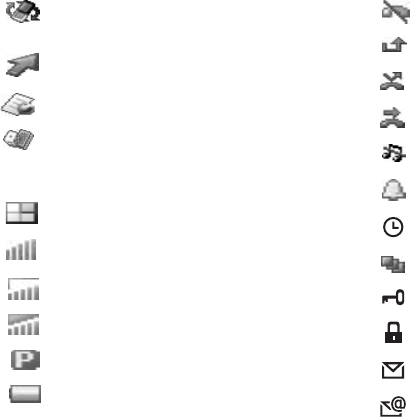
90 Icons
Receive items via Bluetooth, infrared,
networks, data communications settings,
WAP options and accessories.
Create your own menu for the functions you
use most often.
Operator services
Games and applications.
Standby
Desktop icon.
Tells you the strength of the GSM network
signal.
GPRS is within range.
GPRS is within range and can be used.
Tells you are in a premium charge zone.
Tells you the status of the battery.
Icon Description
You cannot receive any incoming calls.
You have missed an incoming call.
All incoming calls are forwarded to a defined
number.
No calls or only certain calls from numbers in
a list are received.
All signals are off, except the alarm and timer.
The alarm clock has been set and is on.
The timer has been set and is on.
A profile other than Normal has been chosen.
The keypad is locked.
The card lock or phonelock is on.
A secure WAP connection is established.
You have received a text message.
You have received an email message.
Icon Description
T610UG-R3A.book Page 90 Tuesday, May 27, 2003 5:16 PM
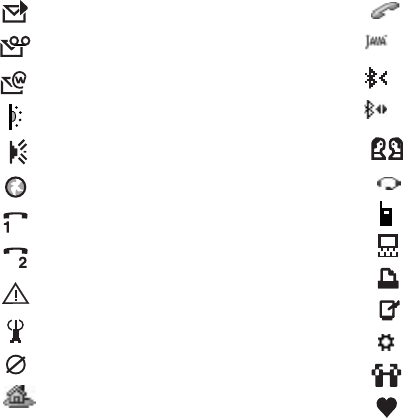
Icons 91
You have received a picture message.
You have received a voice message.
You have received a WAP push message.
The infrared port is on.
Infrared communication is in progress.
A GPRS session is in progress.
Line 1 is in use for outgoing calls.
Line 2 is in use for outgoing calls.
Ciphering is currently not being provided by
the network.
The network is preferred and can be used.
The network is forbidden and cannot be used.
Your home network is within range and can be
used.
Icon Description
An ongoing call.
You are running Java.
Bluetooth is On.
Bluetooth is Active.
A chat session is in progress.
A Bluetooth headset, added to your phone.
A Bluetooth phone, added to your phone.
A Bluetooth PC, added to your phone.
A Bluetooth printer, added to your phone.
A Bluetooth PDA, added to your phone.
Other Bluetooth device.
The appointment is a meeting.
The appointment is a date.
Icon Description
T610UG-R3A.book Page 91 Tuesday, May 27, 2003 5:16 PM
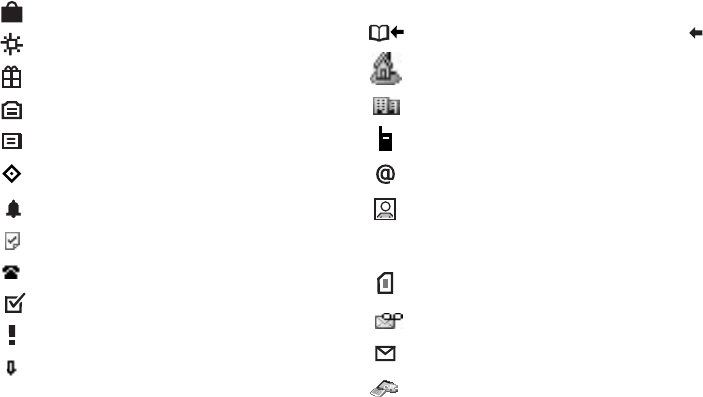
92 Icons
The appointment is to travel.
The appointment is a vacation.
The appointment is an anniversary.
A miscellaneous appointment.
A miscellaneous task.
An all day calendar appointment.
A reminder is set for a calendar appointment.
A task has been set.
The task is a phone call.
A completed task in your calendar.
A task or message of high priority.
A task or message of low priority.
Icon Description
Phonebook
You can enter the phone book by pressing .
A home number in the phone book.
A work number in the phone book.
A mobile number in the phone book.
An email address in the phone book.
A picture is connected to the contact.
Messages
A text message is saved on the SIM card.
A voice message has not been checked.
A message has not been read.
A theme is attached to a message.
Icon Description
T610UG-R3A.book Page 92 Tuesday, May 27, 2003 5:16 PM
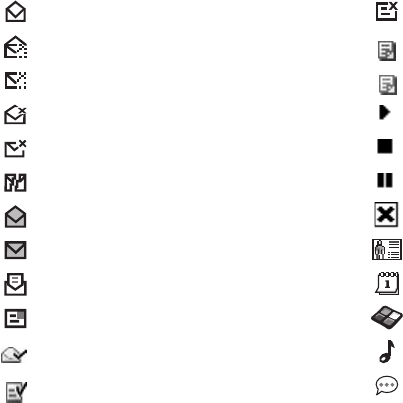
Icons 93
A message has been read.
Only part of a read email message is saved in
the phone.
Only part of an unread email or a multimedia
message is saved in the phone.
A read message will be deleted the next time
you connect to the server.
An unread message will be deleted the next
time you connect to the server.
A damaged message.
A read picture message.
An unread picture message.
The message has not been sent.
The message has been sent.
A message has been read by the recipient.
A message has been delivered to the recipient.
Icon Description
A sent message that has expired or been
rejected by the recipient.
Pre-defined message template (not editable).
User-defined message template.
A picture message is playing.
A picture message has been stopped.
A picture message has been paused.
Picture could not be shown.
A business card is attached to a picture
message.
An event is attached to a picture message.
A theme is attached to a picture message.
A picture message contains a melody.
A picture message contains a recorded sound.
Icon Description
T610UG-R3A.book Page 93 Tuesday, May 27, 2003 5:16 PM
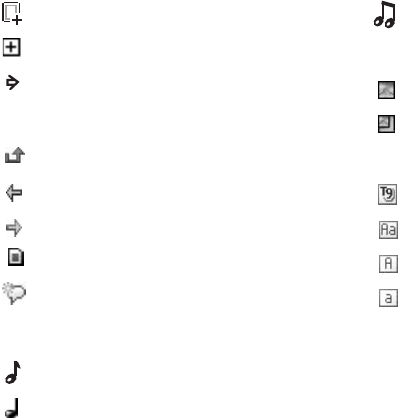
94 Icons
Cursor in a picture message.
More message options.
Chat message prompt.
Calls
A missed call in the call list.
An answered call in the call list.
A dialed number in the call list.
Call from a number on the SIM card.
Your magic word is active.
Multimedia
An i-Melody saved in My sounds.
An e-Melody saved in My sounds.
Icon Description
A polyphonic melody saved in My sounds.
Camera
Large picture size.
Small picture size.
Text input
T9 text input.
Upper & lower case letters.
Upper case letters.
Lower case letters.
Icon Description
T610UG-R3A.book Page 94 Tuesday, May 27, 2003 5:16 PM
Index 95
Index
A
About 4
Alarm clock 70
Answering mode 23
Area information 50
B
Battery 5
Bluetooth wireless technology 66
Business cards 30
C
Calculator 71
Calendar 72
Call costs 37, 43
calling card 41, 43
credit limit 38
minute minder 22
Call time 37
Calls
accept 43
answer 6, 27
automatic redialing 26
call list 27
emergency 26
fixed dialing 42
forward 38
groups 30
international 26
make 6, 25
missed 27
put on hold 39
receive 6, 26
reject 27
restrict 42
speed dialing 31
Camera 53
Cell information 51
Chat 50
Code memo 71
Conference calls 40
Contacts 28
Contrast (display) 22
Credit limit 43
D
Data calls 69
Declaration of conformity 89
Desktop 7
Display
contrast 22
greeting 23
icons 89
light 22
Downloading 65
Drawing pictures 19
E
Email 51
gateway 59
settings 56, 59, 62
Emergency calls 26
Error messages 80
F
Fax, sending and receiving 69
Fixed dialing 42
Forwarding calls 38
G
Games 76
GPRS 60
Greeting 23
Groups 30
closed user groups 43
conference calls 40
T610UG-R3A.book Page 95 Tuesday, May 27, 2003 5:16 PM
96 Index
H
Handsfree 23
Help texts 11
I
Icons (display) 89
Infrared port 68
International calls 26
International emergency number 26
Internet, see WAP 63
K
Key functions 8
Key sound 22
Keypad lock 23
L
Language (display) 22
Locks
keypad 23
phone 78
SIM card 78
M
Magic word 34
Melodies, see Ring tones 20
Melody composer 21
Menu language 22
Minute minder 22, 43
Mirror 55
Missed calls 27
MMS 47
MMS, see Multimedia messages 47
Mobile Internet, see WAP 63
Multimedia messages 47
Multimedia Messaging Service 47
Multitap text input 14
My numbers 23
My shortcuts 24
N
Navigating the menus 7
Networks 6, 43
Notes 77
O
Online services 12
Own number 23
P
Passkey 66
Personal ring tone 21
Phone book 28
check memory 32
Phone lock 78
Picture editor 19
Picture messages 47
Picture messaging 47
Pictures 17
background picture 18
draw 19
edit 18
exchange 19
PIN
change 78
enter 6
PIN2
change 78
Profiles 24
PUK 78
Q
Quick keys 9
R
Redialing 26
Reset 25
Restrict messages 49
Ring tones 20
T610UG-R3A.book Page 96 Tuesday, May 27, 2003 5:16 PM
Index 97
S
Screen saver 20
Security
WAP 60
Shortcuts 9, 24
Silent ring tone 21
SIM card 12
copy contacts 31
unblock 78
SIM card lock 78
SMS, see Text messages 45
Sound recorder 75
Speed dialing 31
Stopwatch 71
Synchronization 69
T
T9 Text input 15
Taking pictures 54
Text messages 45
email gateway 59
Themes 17
Time settings 22
Timer 71
Turning the phone on/off 6
Two voice lines 40
V
Vibrating alert 22
Voice answering 34
Voice control 32
Voice dialing 33
Voicemail 37
W
WAP 63
bookmarks 64
options 64
security 60
settings 56
settings (manual) 57
settings (text message) 57
settings (wizard) 57
Warranty 85
T610UG-R3A.book Page 97 Tuesday, May 27, 2003 5:16 PM
98 Index
T610UG-R3A.book Page 98 Tuesday, May 27, 2003 5:16 PM